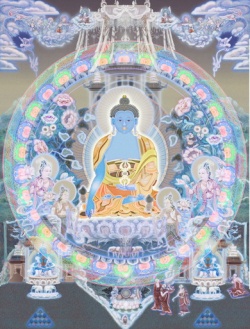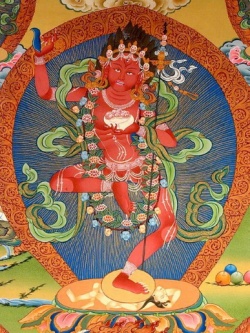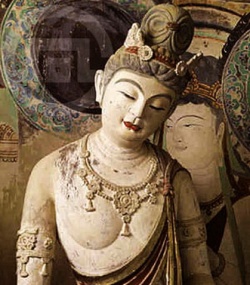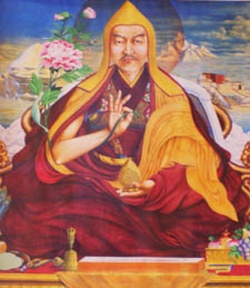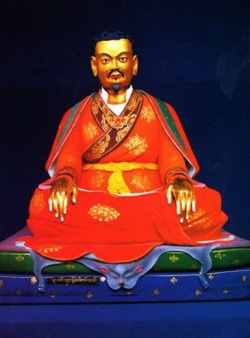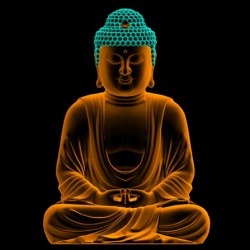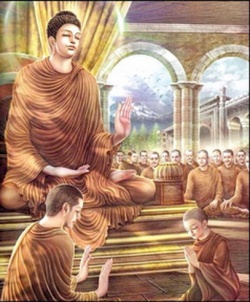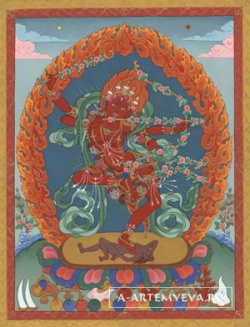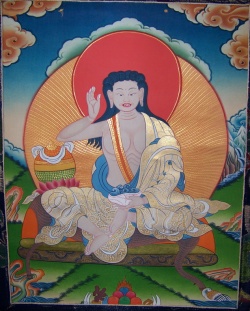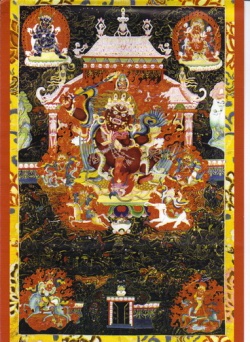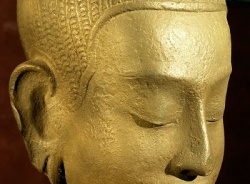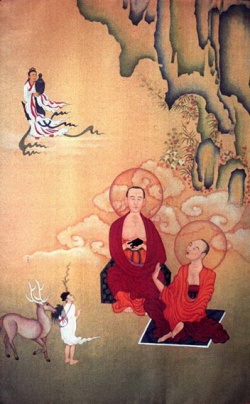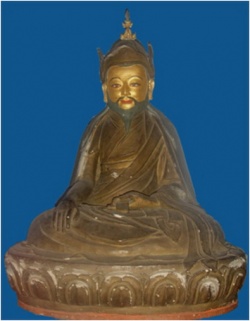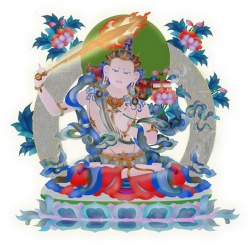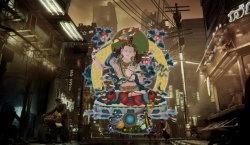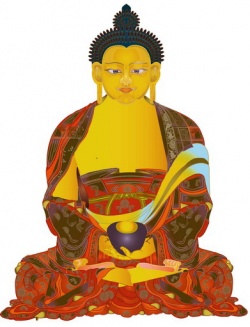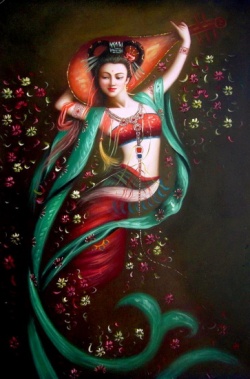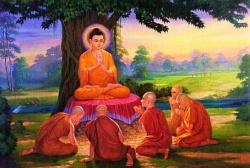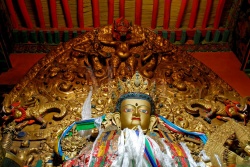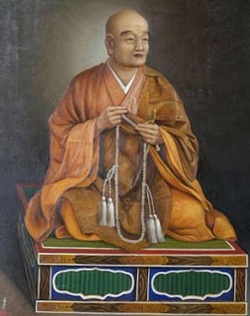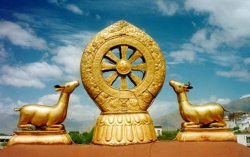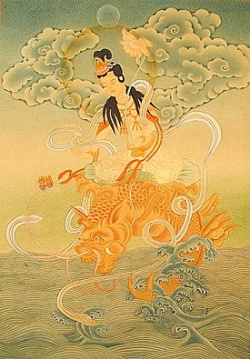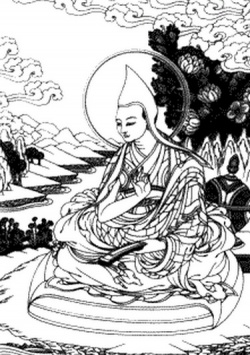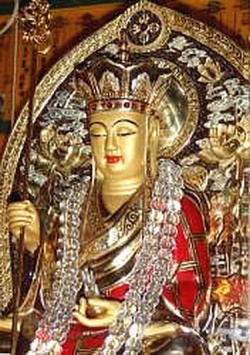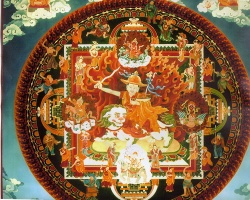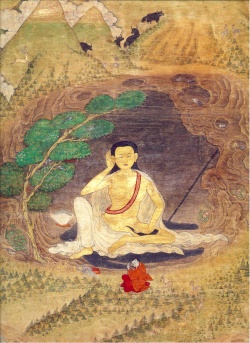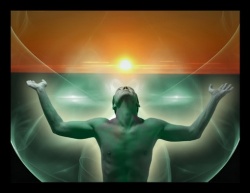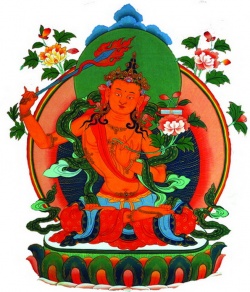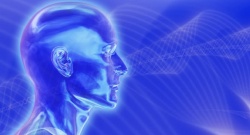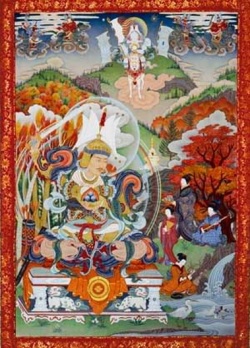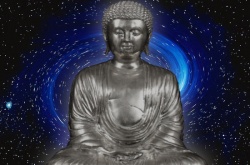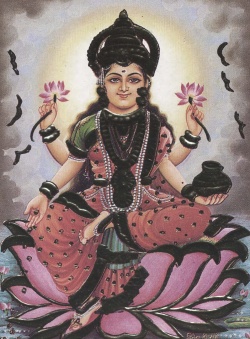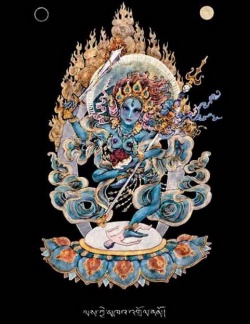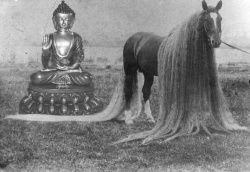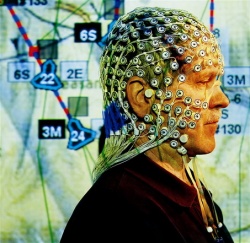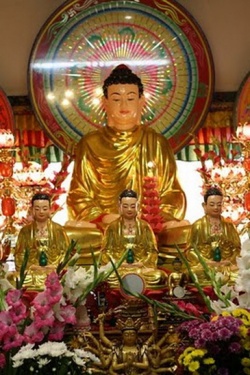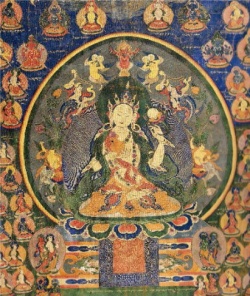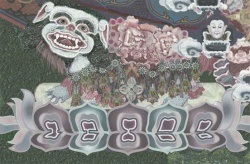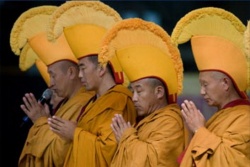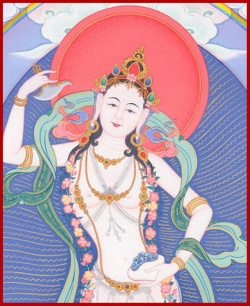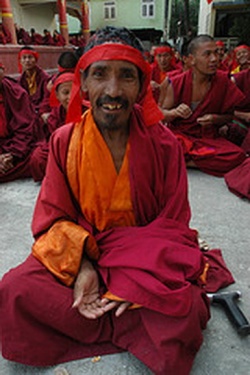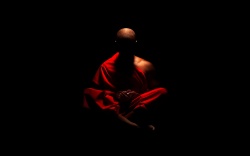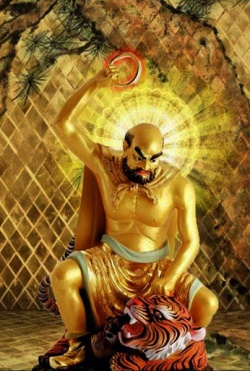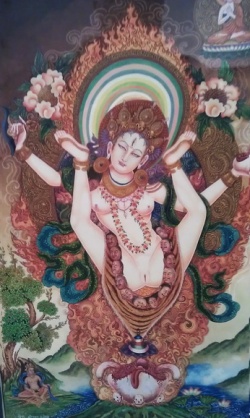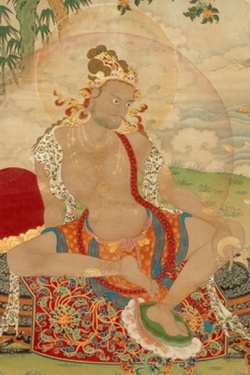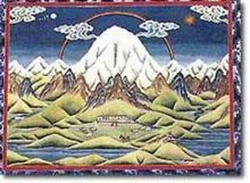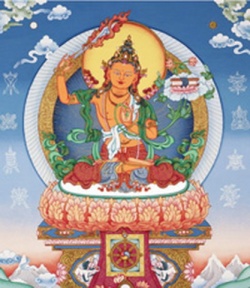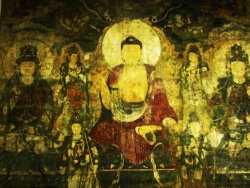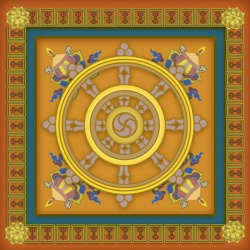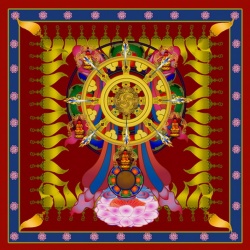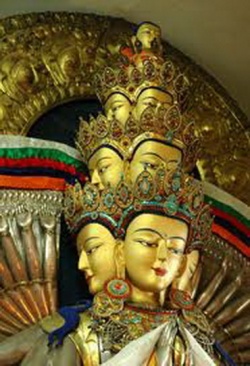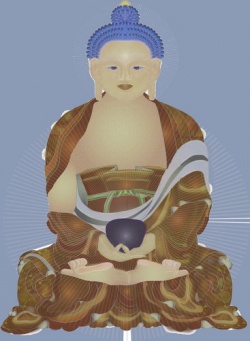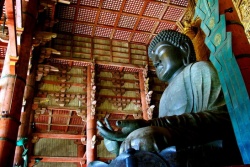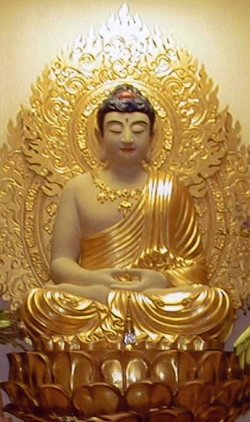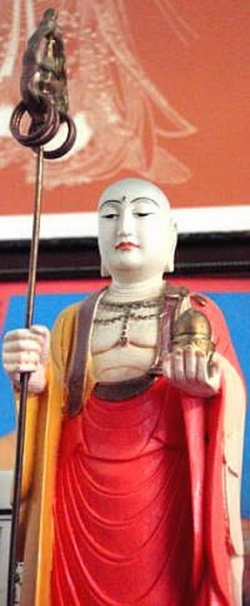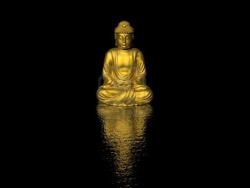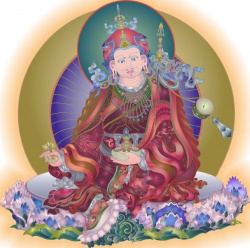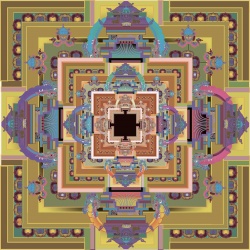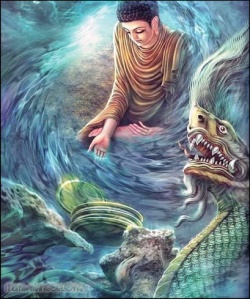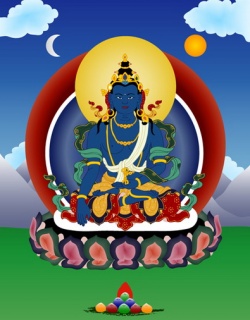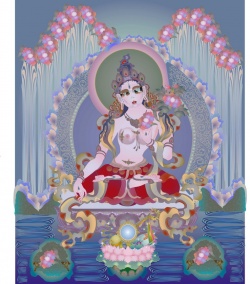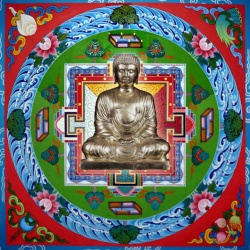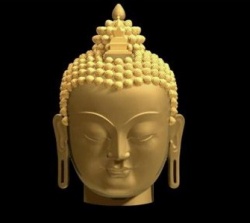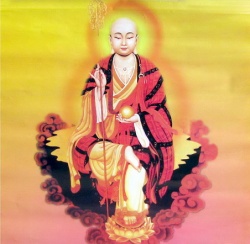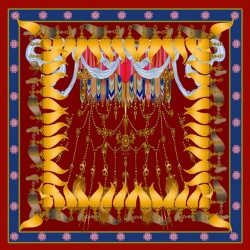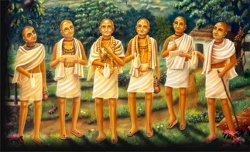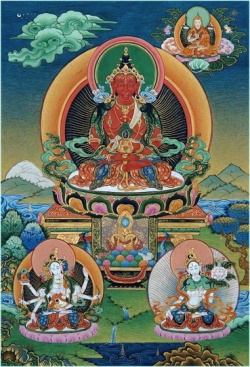The Laṅkāvatāra Sūtra by Daisetz Teitaro Suzuki: CHAPTER TWO. COLLECTION OF ALL THE DHARMAS
The Laṅkāvatāra Sūtra
A Mahāyāna Text
Translated for the first time from
the original Sanskrit by
Daisetz Teitaro Suzuki
Contents
- 1 I[1] Mahāmati Praises the Buddha with Verses
- 2 II Mahāmati's "One Hundred and Eight Questions"
- 3 III "The One Hundred and Eight Negations"
- 4 IV Concerning the Vijñānas
- 5 V Seven Kinds of Self-nature (svabhāva)
- 6 VI Seven Kinds of First Principle (paramārtha), and the Philosophers' Wrong Views regarding the Mind Rejected
- 7 VII Erroneous Views held by Some Brahmans and Śramanas Concerning Causation, Continuation, etc.; The Buddhist Views Concerning Such Subjects as Alayavijñāna, Nirvana, Mind-only, etc.; Attainments of the Bodhisattva
- 8 VIII The Bodhisattva's Discipling himself in Self-realisation
- 9 IX The Evolution and Function of the Vijñānas; The Spiritual Discipline of the Bodhisattva; Verses on the Alaya-ocean and Vijñāna-waves
- 10 X The Bodhisattva is to Understand the Signification of Mind-only
- 11 XI(a) The Three Aspects of Noble Wisdom (āryajñāna)
- 12 XI(b) The Attainment of the Tathāgatakāya
- 13 XII Logic on the Hare's Horns
- 14 XIII Verses on the Alayavijñāna and Mind-only
- 15 XIV Purification of the Outflows, Instantaneous and Gradual
- 16 XV Nishyanda-Buddha, Dharmatā-Buddha, and Nirmāṇa-Buddha
- 17 XVI The Śrāvaka's Realisation and Attachment to the Notion of Self-nature
- 18 XVII The Eternal-Unthinkable
- 19 XVIII Nirvana and Alayavijñāna
- 20 XIX All Things are Unborn
- 21 XX The Five Classes of Spiritual Insight
- 22 XXI Verses on the Triple Vehicle
- 23 XXII Two Classes of the Icchantika
- 24 XXIII The Three Forms of Svabhāva
- 25 XXIV The Twofold Egolessness (nairātmyadvaya-lakshaṇa)
- 26 XXV Assertion and Refutation (samāropāpavāda)
- 27 XXVI The Bodhisattva Assumes Various Personalities
- 28 XXVII On Emptiness (śūnyatā), No-birth, and Non-duality
- 29 XXVIII The Tathagata-Garbha and the Ego-soul
- 30 XXIX A Verse on the Philosophers' Discriminations
- 31 XXX The Four Things Needed for the Constitution of Bodhisattvahood
- 32 XXXI On Causation (Six Kinds), and the Rise of Existence
- 33 XXXII Four Forms of Word-discrimination
- 34 XXXIII On Word and Discrimination and the Highest Reality
- 35 XXXIV Verses on Reality and its Representations
- 36 XXXV Mind-only, Multitudinousness, and Analogies, with an Interpolation on the Dualistic Notion of Existence
- 37 XXXVI The Teaching (dharmadeśanā) of the Tathagatas
- 38 XXXVII Four Kinds of Dhyāna
- 39 XXXVIII On Nirvana
- 40 XXXIX Two Characteristics of Self-nature
- 41 XL Two Kinds of the Buddha's Sustaining Power (adhishṭhāna)
- 42 XLI On the Chain of Causation (pratityasamutpāda)
- 43 XLII Words (abhilāpa) and Realities (bhāva)
- 44 XLIII On Eternality of Sound (nityaśabda), the Nature of Error (bhrānta), and Perversion (viparyāsa)
- 45 XLIV On the Nature of Māyā
- 46 XLV That All Things are Unborn
- 47 XLVI On Name, Sentence, Syllable, and Their Meaning
- 48 XLVII On Inexplicable Statements (vyakṛitānī)
- 49 XLVIII All Things are and are not (Verses on Four Forms of Explanation)
- 50 XLIX On the Śrāvakas, Srotaāpanna, Sakṛidāgāmin, Anāgāmin, and Arhat; on the Three Knots (saṁyojāni)
- 51 L The Intellect (buddhi), Examining and Discrimnating
- 52 LI The Elements, Primary and Secondary
- 53 LII The Five Skandhas
- 54 LIII Four Kinds of Nirvana and the Eight Vijñānas
- 55 LIV The False Imagination Regarding Twelve Subjects
- 56 LV Verses on the Citta, Parikalpita, Paratantra, and Parinishpanna
- 57 LVI The One Vehicle and the Triple Vehicle
- 58 Footnotes
- 59 Continue Reading
- 60 Source
I[1] Mahāmati Praises the Buddha with Verses
(22) At that time Mahāmati the Bodhisattva-Mahāsattva who had visited all the Buddha-lands, together with all the Bodhisattvas, rose from his seat by the power of the Buddhas, drawing his upper garment over one shoulder, placing his right knee on the ground and with folded hands, turning in the direction of the Blessed One, respectfully saluted him, and praised him with the following verses:
1. As thou reviewest the world with thy transcendental knowledge and compassion, it is to thee like an ethereal flower, of which one cannot say whether it is born or destroyed, as (the category of) being and non-being is inapplicable to it.
2. As thou reviewest all things with thy transcendental knowledge and compassion, they are to thee like visions, they are beyond the reach of intellectual grasp, as (the category of) being and non-being is inapplicable to them.
3. As thou reviewest the world with thy transcendental knowledge and compassion, it is to thee always like a dream, of which one cannot say whether it is permanent or destructible, as (the category of) being and non-being is inapplicable to it.
4. In the Dharmakāya, whose self-nature is like a vision or a dream, what is there to praise? When no thought arises as to existence or as to not-having-self-nature, then there is praise.
5. Of a thing whose appearance is not visible because of its being beyond the senses and their objects (23), how can it be praised or blamed, O Muni?
6. With thy transcendental knowledge and compassion which are above form, thou comprehendest the egolessness of things and persons, and art thyself always clean and free from the hindrances of passion and knowledge.
7. Thou dost not vanish in Nirvana, nor is Nirvana abiding in thee; for it transcends the duality of knowing and known and of being and non-being.
8. Those who see the Muni so serene and beyond birth (and death) will be cleansed of attachment, stainless both in this world and in the other.
II Mahāmati's "One Hundred and Eight Questions"
At that time Mahāmati the Bodhisattva-Mahāsattva praising the Blessed One with such verses as these, made his own name known to the Blessed One.
9. I am Mahāmati, Blessed One, and am well versed in the Mahāyāna. I wish to ask one hundred and eight questions of thee who art most eloquent.
10. Hearing his words the Buddha, the best knower of the world, looking over the whole assembly, spoke to the son of the Sugata thus:
11. Ask me, sons of the Victorious, and Mahāmati, you ask and I will instruct you in self-realisation.
At that moment Mahāmati the Bodhisattva-Mahāsattva who was given by the Blessed One the opportunity to speak, prostrated himself at the feet of the Blessed One and asked:
(24) 12. How can one be cleansed of false intellection? Whence does it arise? How can one perceive errors? Whence do they arise?
13. Whence come lands, transformation, appearance, and philosophers? Wherefore is the state of imagelessness, the gradations, and whence are the sons of the Victorious?
14. Where is the way of emancipation? Who is in bondage? By what is he redeemed? What is the mental state of those who practise the Dhyānas? Whence is the triple vehicle?
15. What is that which is born of causation? What is effect? What is cause (or that which works)? Whence the doctrine of duality? Whence does it arise?
16. Wherefore is the tranquilising exercise of formlessness? And that of complete extinction? Wherefore the extinction of thoughts? And how is one awakened from it?
17. How does action rise? Whence is the behaviour of those who hold the body? Whence (this) visible (world)? Whence the conditions? Whence the entrance upon the stages?
18. Who is it that breaks through this triple existence? What is the abode? What is the body? Where does that which is abiding arise? Whence comes the son of the Buddha?
19. Who attains the psychic faculties, the self-masteries, the Samādhis? How is the mind tranquilised? Pray tell me, O Bull-like Victor?
20. What is the Ālaya? And whence the Manovijñāna? (25) How does the visible (world) rise? How does it cease from being visible?
21. Whence are families and no-families? What is meant by Mind-only? The setting up of marks? And whence (the doctrine of) egolessness?
22. Why is there no being? What kind of teaching is in accordance with popular thinking? How can one cease cherishing eternalism (śāśvata-darshana) and nihilism (uccheda-darshana)?
23. How is it that you do not differ from the philosophers as regards appearance? Tell me, whence is the rise of the Nyāya school? Its future?
24. What is meant by emptiness? What do you understand by momentary destruction? Whence is the Womb? And whence is the stability of the world?
25. Why is the world like a vision and a dream? How does it resemble the city of the Gandharvas? Why it is to be regarded as like a mirage, or like the moon reflected in water? Pray tell me.
26. What are the elements of enlightenment? Whence are the constituents of enlightenment? Wherefore is a revolution, and the disturbance of a kingdom? And how does the realistic view of existence (bhavadṛishṭi) take its rise?
27. What is meant by the world being above birth and death? or being like the flower in the air? How do you understand it? Why do you regard it as being beyond words?
28. How is it not subject to discrimination? How is it like the sky? Of how many sorts is suchness? How manifold is the Mind? How many Pāramitās are there?
29. Whence is the gradation of the stages? What is the state of imagelessness? (26) Wherefore is the twofold egolessness? How is one cleansed of (the hindrance of) knowledge?
30. Of how many kinds is knowledge (jñāna)? O Leader! How many moral precepts are there? and forms of being? Whence are the families born of gold and jewel and pearl?
31. Of whom is speech born? Whence is the differentiation of beings? Whence are the sciences, offices, arts? and by whom are they made manifest?
32. Of how many sorts are gāthās? What is prose? What is metre? Of how many sorts is reasoning and exegesis?
33. How many varieties of food and drink are there? Whence does sexual desire originate? Whence are there kings, sovereigns, and provincial rulers?
34. How does a king protect his dominion? Of how many groups are heavenly beings? Whence are the earth, stars, constellations, the moon, and the sun?
35. How many kinds of emancipation are there? of the Yogins? How many kinds of discipleship? And how about the masters?
36. How many kinds of Buddhahood are there? And how many of the Jātaka Tales? How numerous are the evil ones? How numerous are the heretics?
37. What is meant by (the doctrine) that there is nothing but thought-construction? Pray tell me, thou Most Eloquent One?
(27) 38. Whence are the clouds in the sky? the wind? What is meant by recollection? by wisdom (medhā)? Whence are trees and vines? Pray tell me, Lord of the Triple World?
39. How do horses, elephants, and deer get caught? Wherefore are there fools and despicable people? Pray tell me, thou Charioteer of the Mind?
40. Wherefore are the six seasons mentioned? What is meant by the Icchantika (one who is without Buddha-nature)? Pray tell me whence is the birth of a man? of a woman? of a hermaphrodite?
41. How does one retrograde in the Yoga exercises? How does one make progress in them? How many exercises are there? and how are men kept abiding in them? Pray tell me.
42. Beings are born in the various paths of existence, what are their specific marks and forms? How is abundance of wealth acquired? Pray tell me, thou who art like the sky?
43. Whence is the Śākya family? And the one born of Ikshvāku? Whence is the Rishi Long-Penance? What is taught by him?
44. How is it that thou art thus apparent everywhere in every land, surrounded by such Bodhisattvas of such various names and forms?
45. Why is meat not to be eaten? Why is it forbidden? Whence was the carnivorous race born, who eats meat?
46. Why are the lands shaped like the moon, the sun, the Sumeru, the lotus, the swatika, and the lion? Pray tell me.
(28) 47. Wherefore are the lands shaped like a capsized and upturned net of Indra which is composed of all sorts of jewels? Pray tell me why?
48. Wherefore are (the lands) shaped in the form of a lute or a drum? Like various flowers and fruits? Like the sun and the moon which are so stainless? Pray tell me.
49. Whence are the Buddhas of Transformation? Whence are the Buddhas of Maturity (or Recompense)? Whence are the Buddhas who are endowed with transcendental knowledge of suchness? Pray tell me.
50. Why does not one attain enlightenment in the world of desire? Pray tell me. What is the meaning of your being enlightened in the Akanishṭha by shaking off all the passions?
51. After my passing who will be the upholder of the Discipline (or Doctrine, śāsana)! How long should the teacher abide? How long should the teaching continue?
52. How many sorts of established truths are there? And how many of philosophical views? Whence is morality? And what constitutes the being of a Bhikshu? Pray tell me.
53. What is meant by a state of revulsion (or turning-back)? Whence is a state of imagelessness, (which is realised) by the Pratyekabuddhas, Bodhisattvas, and Śrāvakas?
54. By whom are the psychic powers of this world attained? What are the super-worldly ones? By what means does the mind enter upon the seven stages? Pray tell me.
55. How many kinds of Brotherhood are there? And how does a dissension take place in a Brotherhood! Whence are medical treatises for beings? Pray tell me.
(29) 56. You say that you were among the Buddhas Kāśyapa, Krakuchanda, and Kanakamuni; tell me wherefore so, O Great Muni!
57. Whence is the doctrine that there is no ego-soul in beings? Whence is the doctrine of eternity, and of annihilation? Wherefore do you not everywhere announce the doctrine of Mind-only as the truth?
58. What is meant by the forest of men and women? And by the forest of Karītakī and Āmalī? Whence are the mountains Kailāsa, Cakravāḍa, and Vajrasaṃhananā?
59. Among these, whence are the mountains decorated with various sorts of jewels and filled with Ṛishis and Gandharvas? Pray tell me.
60. Hearing this (which constitutes) the wonderful doctrine of the Mahāyāna and also the most excellent heart of the Buddhas, the Great Hero, the Buddha, the One Most Excelled in the Knowledge of the World, (spoke thus):
61. Well done! Well done! O Mahāprajñā-Mahāmati! Listen well, and I will tell you in order regarding your questions.
62. Birth, no-birth, Nirvana, emptiness, transmigration, having-no-selḹ-nature, Buddhas, sons of the Pāramitās,
63. The Śrāvakas, Bodhisattvas, the philosophers, those who are capable of formless deeds, the Meru, oceans, mountains, islands, lands, the earth,
64. The stars, the sun, the moon, the philosophers, the Asura, (30) emancipations, the self-masteries, the psychic faculties, the Dhyānas, the Samādhis,
65. The extinctions (nirodha), the supernatural powers, the elements of enlightenment, and the paths, Dhyānas, the unmeasurables, the aggregates (skandhas), and the comings-and-goings.
66. Samāpattis, the extinctions, the stirrings of mind, explanations in words, the Citta, Manas, and Vijñānas, egolessness, the five Dharmas,
67. Self-nature, the discriminating, the discriminated, the visible (world), dualism—whence are they? Various forms of vehicles, families, those born of gold, jewels, and pearls?
68. The Icchantika, the original elements, the wandering-about, one Buddhahood, knowledge, the known, the marching, the attainment, and the existence and non-existence of beings?
69. How are horses, elephants, deer caught? Pray tell me how. What is a proposition, a teaching established by the conjunction of reason and illustration?
70. Whence is cause and effect? Various errors? and also reason? (Why the statement that there is) nothing but Mind, that there is no objective (literally, seen) world, that there is no ascending of the stages?
71. Whence is the state of imagelessness and revulsion which is a hundredfold?[2] You tell me. Likewise about medical treatises, arts, crafts, sciences, and teachings?
72. And also what are the measurements of the mountains, Sumeru, and the earth? What are the measurements of the ocean, moon, and sun? Tell me.
(31) 73. How many particles of dust are there in the body of a being? How many of the coarser ones, of the finer ones, and of the middle ones? How many particles of dust in every land? How many in every dhanva?
74. In measuring distance how much is a hasta, a dhanu, a krośa, a yojana, a half-yojana? How many of rabbit-hairs, of window-dust, louse-eggs, or ram-hairs, of barley?[3]
75. How many grains of barley in a prastha? How many grains of barley in a half-prastha? Likewise how many in a droṇa, in a khārya, a lakshā, a koṭi, a vimvana?
76. How many atoms are there in a mustard-seed? How many mustard-seeds are there in a rakshikā? How many in a bean, in a dharaṇa, in a māshakā?
77. How many dharaṇās are there in a karsha? How many karshas in a pala? and how many palas are there in Mount Sumeru which is a huge accumulation (of masses)?
78. You should ask me thus, O son! Why do you ask me otherwise? How many atoms are there in the body of a Pratyekabuddha, of a Śrāvaka, of a Buddha, and of a Bodhisattva? (32) Why do you not ask me in this wise?
79. How many atoms are there at the top of a flame? How many atoms are in the wind? How many in each sense-organ? How many in a pore of the skin? in the eyebrows?
80. Whence are these men of immense wealth, kings, great sovereigns? How is the kingdom taken care of by them? And how about their emancipation?
81. Tell whence is prose and metre. Why is sexual desire universally cherished? Whence is the variety of foods and drinks? Whence the man-woman forest?
82. Wherefore are the mountains of Vajrasaṃhanana? Tell me whence, wherefore; are they like a vision, a dream, and a fata-morgana?
83. Whence is the arising of clouds? And whence do the seasons rise? Whence is the nature of taste? Whence is woman, man, and hermaphrodite?
84. Whence are the adornments and the Bodhisattvas? Ask me, O my son! Whence are the divine mountains embellished by the Rishis and Gandharvas?
85. Whence is the way of emancipation? Who is in bondage? By whom is he delivered? What is the state of one who practises tranquillisation? What is transformation, and who are those philosophers?
86. What is meant by non-existence, existence, and no-effect? Whence arises the visible world? (33) How can one be cleansed of false intellection? Whence does false intellection arise?
87. Whence arises action? And whence its departure? Tell me. How does the extinction of thought take place? And what is meant by a Samādhi?
88. Who is the one that breaks through the triple world? What is the position? What is the body? Wherefore the doctrine that beings have no ego-soul? What is meant by a teaching in accordance with the world?[4]
89. Do you ask me about the marks? Do you ask me about egolessness? Do you ask me about the womb, about the Nyāya philosophers, O son of the Victor?
90. How about eternalism and nihilism? How is the mind tranquillised? Again (how about) speech, knowledge, morality, family, O son of the Victor?
91. What is meant by reasoning and illustrating, by master and disciple, by manifoldness of beings, food and drink, sky, intelligence, evil ones, and the statement that there is nothing but the thought-constructed?
92. What do you ask me concerning trees and vines, O son of the Victor? What about diversity of lands, and about Long-Penance the Ṛishi?
93. What is your family? Who is your master? You tell me, O son of the Victor. Who are the people who are despised? How is it that in the Yoga you do not attain enlightenment in the world of desire, but that in the Akanishṭha there is realisation?
94. What do you ask me about reasoning? (34) What about the psychic faculties belonging to this world, and about the nature of a Bhikshu?
95. Do you ask me about Buddhas of Transformation, Buddhas of Maturity (or Recompense)? About Buddhas of the Knowledge of Suchness? And whence is the Bodhisattva?
96. You ask me, O son of the Victor, about the lands that are devoid of light, resembling a lute, a drum, and a flower, and about the mind abiding in the seven stages?
97. You ask me such and many other questions, which are in accordance with the marks (of Truth?) and free from erroneous views.
III "The One Hundred and Eight Negations"
98.[5] I will instruct you as regards realisation and its teaching; listen to me intently; I will give you an explanation of the statements, O son, listen to me, in regard to the one hundred and eight statements as recounted by the Buddhas.
At that moment Mahāmati the Bodhisattva-Mahāsattva said to the Blessed One: What is meant by the one hundred and eight statements?[6]
The Blessed One said: A statement concerning birth is no statement concerning birth; a statement concerning eternity is no statement concerning eternity. (The topics thus negated are as follows:[7]) the characteristic marks, abiding and changing, moment, self-nature, emptiness, annihilation, mind, the middle, permanence, causation, cause, the passions, desire, (35) means, contrivance, purity, inference (or conclusion), illustration, a disciple, a master, a family, the triple vehicle, imagelessness, vows, the triple circle, form, duality of being and non-being, bothness, the noble wisdom of self-realisation, the bliss of the present world, lands, atoms, water, a bow, reality, numbers and mathematics, the psychic powers, the sky, clouds, the arts and crafts and sciences, the wind, the earth, thinking, thought-constructions, self-nature, the aggregates, being, insight, Nirvana, that which is known, the philosophers, disorder, a vision, a dream, (36) a mirage, a reflection, a circle made in the dark by a fire-brand, the city of the Gandharvas, the heavens, food and drink, sexuality, philosophical views, the Pāramitās, morality, the moon and the sun and stars, truth, effect, annihilation and origination, medical treatment, the characteristic marks, the limbs, arts and sciences, Dhyāna, error, the seen (world), protection, dynasty, Ṛishi, kingdom, apprehension, treasure, explanation, the Icchantika, man, woman, and hermaphrodite, taste, action, the body, false intellection, motives, sense-organs, the Samskrita,[8] cause and effect, the Kanishṭha,[9] the seasons, a luxuriant growth of trees, vines and shrubs, (37) multiplicity, entering into the teaching, systems of morality, the Bhikshus, the powers added (by the Buddha), the lutes. These are the one hundred and eight statements recounted by the Buddhas of the past.
IV Concerning the Vijñānas
At that moment, Mahāmati the Bodhisattva-Mahāsattva said again to the Blessed One: In how many ways, Blessed One, does the rise, abiding, and ceasing of the Vijñānas take place?
The Blessed One replied: There are two ways, Mahāmati, in which the rise, abiding, and ceasing of the Vijñānas take place, and this is not understood by the philosophers. That is to say, the ceasing takes place as regards continuation and form. In the rise of the Vijñānas, also, these two are recognisable: the rise as regards continuation and the rise as regards form. In the abiding, also, these two (are discernible): the one taking place as regards continuation and the other as regards form.
(Further,) three modes are distinguishable in the Vijñānas: (1) the Vijñāna as evolving, (2) the Vijñāna as producing effects, and (3) the Vijñāna as remaining in its original nature.
(Further,) Mahāmati, in the Vijñānas, which are said to be eight, two functions generally are distinguishable, the perceiving and the object-discriminating. As a mirror reflects forms, Mahāmati, the perceiving Vijñā a perceives (objects). Mahāmati, between the two, the perceiving Vijñāna and the object-discriminating Vijñāna, there is no difference; they are mutually conditioning. Then, Mahāmati, the perciving Vijñāna functions because of transformation's taking place (in the mind) by reason of a mysterious habit-energy, while, Mahāmati, the object-discriminating Vijñāna (38) functions because of the mind's discriminating an objective world and because of the habit-energy accumulated by erroneous reasoning since beginningless time.
Again, Mahāmati, by the cessation of all the sense-Vijñānas is meant the cessation of the Ālayavijñāna's variously accumulating habit-energy which is generated when unrealities are discriminated. This, Mahāmati, is known as the cessation of the form-aspect of the Vijñānas.
Again, Mahāmati, the cessation of the continuation-aspect of the Vijñānas takes place in this wise: that is to say, Mahāmati, when both that which supports (the Vijñānas) and that which is comprehended (by the Vijñānas) cease to function. By that which supports (the Vijñānas) is meant the habit-energy (or memory) which has been accumulated by erroneous reasoning since beginningless time; and by that which is comprehended (by the Vijñānas) is meant the objective world perceived and discriminated by the Vijñānas, which is, however, no more than Mind itself.
Mahāmati, it is like a lump of clay and the particles of dust making up its substance, they are neither different nor not-different; again, it is like gold and various ornaments made of it. If, Mahāmati, the lump of clay is different from its particles of dust, no lump will ever come out of them. But as it comes out of them it is not different from the particles of dust. Again, if there is no difference between the two, the lump will be indistinguishable from its particles.
Even so, Mahāmati, if the evolving Vijñāna are different from the Ālayavijñāna, even in its original form, the Ālaya cannot be their cause. Again, if they are not different the cessation of the evolving Vijñānas will mean the cessation of the Ālayavijñāna, but there is no cessation of its original form. Therefore, Mahāmati, what ceases to function is not the Ālaya in its original self-form, but is the effect-producing form of the Vijñānas. When this original self-form ceases to exist, then there will indeed be the cessation of the Ālayavijñāna. (39) If, however, there is the cessation of the Ālayavijñāna, this doctrine will in no wise differ from the nihilistic doctrine of the philosophers.
This doctrine, Mahāmati, as it is held by the philosophers, is this: When the grasping of an objective world ceases the continuation of the Vijñānas is stopped; and when there is no more of this continuation in the Vijñānas, the continuation that has been going on since beginningless time is also destroyed. Mahāmati, the philosophers maintain that there is a first cause from which continuation takes place; they do not maintain that the eye-Vijñāna arises from the interaction of form and light; they assume another cause. What is this cause, Mahāmati? Their first cause is known as spirit (pradhāna), soul (purusha), lord (iśvara), time, or atom.
V Seven Kinds of Self-nature (svabhāva)
Again, Mahāmati, there are seven kinds of self-nature: collection (samudaya), being (bhāva), characteristic marks (lakshaṇa), elements (mahābhūta), causality (hetu), conditionality (pratyaya), and perfection (nishpatti).[10]
VI Seven Kinds of First Principle (paramārtha), and the Philosophers' Wrong Views regarding the Mind Rejected
Again, Mahāmati, there are seven kinds of first principle (or highest reality, paramārtha): the world of thought (citta-gocara), the world of knowledge (jñāna-), the world of super-knowledge (prajñā-), the world of dualistic views (dṛishṭi-), the world beyond dualistic views, the world beyond the Bodhisattva-stages, and a world where the Tathagata attains his self-realisation.[11]
(40) Mahāmati, this is the self-nature, the first principle, the essence, which constitutes the being of the Tathagatas, Arhats, Fully-Enlightened Ones of the past, present, and future, whereby, perfecting things of this world and of a world beyond this, they, by means of a noble eye of transcendental wisdom, enter into various phases of existence, individual and general, and establish them. And what is thus established by them is not to be confused with the erroneous teachings generally held by the philosophers.
Mahāmati, what are these erroneous teachings accepted generally by the philosophers? (Their error lies in this) that they do not recognise an objective world to be of Mind itself which is erroneously discriminated; and, not understanding the nature of the Vijñānas which are also no more than manifestations of Mind, like simple-minded ones that they are, they cherish the dualism of being and non-being where there is but (one) self-nature and (one) first principle.
Again, Mahāmati, my teaching consists in the cessation of sufferings arising from the discrimination of the triple world; in the cessation of ignorance, desire, deed, and causality; and in the recognition that an objective world, like a vision, is the manifestation of Mind itself.
VII Erroneous Views held by Some Brahmans and Śramanas Concerning Causation, Continuation, etc.; The Buddhist Views Concerning Such Subjects as Alayavijñāna, Nirvana, Mind-only, etc.; Attainments of the Bodhisattva
Mahāmati, there are some Brahmans and Śramaṇas who assume something out of nothing, saying that there exists a substance which is bound up in causation and abides in time, and that the Skandhas, Dhātus, and Āyatanas have their genesis and continuation in causation and, after thus existing, pass away.
They are those, Mahāmati, who hold a destructive and nihilistic view concerning such subjects as continuation, activity, rising, breaking-up, existence, Nirvana, the path, karma, fruition, and truth. (41) Why? Because they have not attained an intuitive understanding (of the Truth), because they have no fundamental insight of things. Mahāmati, it is like a jar broken in pieces which is unable to function as a jar; again, it is like a burnt seed which is incapable of sprouting. Even so, Mahāmati, their Skandhas, Dhātus, and Āyatanas which they regard as subject to changes are really incapable of uninterrupted transformation because their views do not originate from the perception of an objective world as a manifestation of Mind itself which is erroneously discriminated.
If again, Mahāmati, something comes out of nothing and there is the rise of the Vijñānas by reason of a combination of the three effect-producing causes, we can say the same of a non-existing thing, that a tortoise would grow hair and sands produce oil. (As this is impossible) this proposition does not avail, it ends in affirming nothing. And, Mahāmati, it follows that deed, work, and cause (of which they speak) will be of no use, and so also with their reference to being and non-being. Mahāmati, when they argue that there is a combination of the three effect-producing causes, they do this by the principle of cause and effect (which is to say, by the principle that something comes out of something and not of nothing); and thus there are (such things as) past, present, and future, and being and non-being. As long as they remain on their philosophic ground, their demonstration will be by means of their logic and text-books, for the memory of erroneous intellection will ever cling to them. [12] Thus, Mahāmati, simple-minded ones, poisoned by an erroneous view, declare the incorrect way of thinking taught by the ignorant to be the one presented by the All-Knowing One.
Again, Mahāmati, there are some Brahmans and Śramaṇas who (42) recognising that the external world which is of Mind itself is seen as such owing to the discrimination and false intellection practised since beginningless time, know that the world has no self-nature and has never been born, it is like a cloud, a ring produced by a firebrand, the castle of the Gandharvas, a vision, a mirage, the moon as reflected in the ocean, and a dream; that Mind in itself has nothing to do with discrimination and causation, discourses of imagination, and terms of qualification (lakshya-lakshaṇa); that body, property, and abode are objectifications of the Ālayavijñāna,[13] which is in itself above (the dualism of) subject and object; that the state of imagelessness which is in compliance with the awakening of Mind itself,[14] is not affected by such changes as arising, abiding, and destruction.
The Bodhisattvas-Mahāsattvas, Mahāmati, will before long attain to the understanding that Nirvana and Samsāra are one. Their conduct, Mahāmati, will be in accordance with the effortless exhibition of a great loving heart that ingeniously contrives means (of salvation), knowing that all beings have the nature of being like a vision or a reflection, and that (there is one thing which is) not bound by causation, being beyond the distinction of subject and object; (and further) seeing that there is nothing outside Mind, and in accordance with a position of unconditionality, they will by degrees pass through the various stages of Bodhisattvahood and will experience the various states of Samādhi, and will by virtue of their faith understand that the triple world is of Mind itself, and thus understanding will attain the Samādhi Māyopama. The Bodhisattvas entering into the state of imagelessness where they see into the truth of Mind-only, arriving at the abode of the Pāramitās, and keeping themselves away from the thought of genesis, deed, and discipline, they will attain the Samādhi Vajravimbopama which is in compliance with the Tathāgatakāya and with the transformations of suchness. After achieving a revulsion in the abode (of the Vijñānas), Mahāmati, they will gradually realise the Tathāgatakāya, which is endowed with the powers, the psychic faculties, self-control, love, compassion, and means; which can enter into all the Buddha-lands and into the sanctuaries of the philosophers; and which is beyond the realm of (43) Citta-mano-manovijñāna. Therefore, Mahāmati, these Bodhisattva-Mahāsattvas who wish, by following the Tathāgatakāya, to realise it, should exercise themselves, in compliance with the truth of Mind-only, to desist from discriminating and reasoning erroneously on such notions as Skandhas, Dhātus, Āyatanas, thought, causation, deed, discipline, and rising, abiding, and destruction.
VIII The Bodhisattva's Discipling himself in Self-realisation
Perceiving that the triple existence is by reason of the habit-energy of erroneous discrimination and false reasoning that has been going on since beginningless time, and also thinking of the state of Buddhahood which is imageless and unborn, (the Bodhisattva) will become thoroughly conversant with the noble truth of self-realisation, will become a perfect master of his own mind, will conduct himself without effort, will be like a gem reflecting a variety of colours, will be able to assume the body of transformation, will be able to enter into the subtle minds of all beings, and, because of his firm belief in the truth of Mind-only, will, by gradually ascending the stages, become established in Buddhahood. Therefore, Mahāmati, let the Bodhisattva-Mahāsattva be well disciplined in self-realisation.
IX The Evolution and Function of the Vijñānas; The Spiritual Discipline of the Bodhisattva; Verses on the Alaya-ocean and Vijñāna-waves
Then Mahāmati said: Teach me, Blessed One, concerning that most subtle doctrine which explains the Citta, Manas, Manovijñāna, the five Dharmas, the Svabhāvas, and the Lakshanas; which is put in practice by the Buddhas and Bodhisattvas; which is separated from the state of mind which recognises a world as something outside Mind itself; and which, breaking down all the so-called truths established by words and reasonings, constitutes the essence of the teachings of all the Buddhas. Pray teach this assembly headed by the Bodhisattvas gathering on Mount Malaya in the city of Laṅkā; teach them regarding the Dharmakāya which is praised by the Tathagatas and which is the realm of (44) the Ālayavijñāna which resembles the ocean with its waves. Then the Blessed One again speaking to Mahāmati the Bodhisattva-Mahāsattva said this: The reasons whereby the eye-consciousness arises are four. What are they? They are: (1) The clinging to an external world, not knowing that it is of Mind itself; (2) The attaching to form and habit-energy accumulated since beginningless time by false reasoning and erroneous views; (3) The self-nature inherent in the Vijñāna; (4) The eagerness for multiple forms and appearances. By these four reasons, Mahāmati, the waves of the evolving Vijñānas are stirred on the Ālayavijñāna which resembles the waters of a flood. The same (can be said of the other sense-consciousnesses) as of the eye-consciousness. This consciousness arises at once or by degrees in every sense-organ including its atoms and pores of the skin; the sense-field is apprehended like a mirror reflecting objects, like the ocean swept over by a wind. Mahāmati, similarly the waves of the mind-ocean are stirred uninterruptedly by the wind of objectivity; cause, deed, and appearance condition one another inseparably; the functioning Vijñānas and the original Vijñāna are thus inextricably bound-up together; and because the self-nature of form, etc., is not comprehended, Mahāmati, the system of the five consciousnesses (vijñānas) comes to function. Along with this system of the five Vijñānas, there is what is known as Manovijñāna (i. e., the thinking function of consciousness), whereby the objective world is distinguished and individual appearances are distinctly determined, and in this the physical body has its genesis. But the Manovijñāna and other Vijñānas have no thought that they are mutually conditioned and that they grow out of their attachment to the discrimination which is applied to the projections of Mind itself. Thus the Vijñānas go on functioning mutually related in a most intimate manner and discriminating a world of representations.
(45) As the Vijñānas thus go on functioning (without being conscious of their own doings), so the Yogins while entering upon a state of tranquillisation (Samāpatti) are not aware of the workings of the subtle habit-energy (or memory) within themselves; for they think that they would enter upon a state of tranquillisation by extinguishing the Vijñānas. But (in fact) they are in this state without extinguishing the Vijñānas which still subsist because the seeds of habit-energy have not been extinguished; and (what they imagine to be) an extinction is really the non-functioning of the external world to which they are no more attached. So it is, Mahāmati, with the subtle working of the Ālayavijñāna, which, except for the Tathagata and those Bodhisattvas who are established on the stages, is not easy to comprehend; (especially) by those who practise the discipline belonging to the Śrāvakas, Pratyekabuddhas, and philosophers, even with their powers of Samādhi and transcendental knowledge, it is difficult to distinguish. Only those who, understanding fully all the aspects of the different stages of Bodhisattvahood by the aid of their transcendental knowledge, acquiring a definite cognition as regards the meaning of the separate propositions, planting roots of goodness in the Buddha-lands that know no limits, and keeping themselves away from the discriminations and false reasonings that arise from recognising an external world which is of Mind itself, would retire into a secluded abode in the forest and devote themselves to the practice of the spiritual discipline, either high, or low, or middling, only those are capable of obtaining an insight into the flowing of Mind itself in a world of discrimination, of being baptised by the Buddhas living in the lands without limits, and of realising the self-control, powers, psychic faculties, and Samādhis. Surrounded by good friends and the Buddhas, Mahāmati, they are capable of knowing the Citta, Manas, Manovijñāna, which are the discriminating agents of an external world whose self-nature is of Mind itself; they are capable of crossing the ocean of birth and death which arises by reason of deed, desire, and ignorance. For this reason, Mahāmati, the Yogins ought to exercise themselves in the discipline which has been given them by their good friends and the Buddhas.
(46) At that time the Blessed One recited the following verses:
99. Like waves that rise on the ocean stirred by the wind, dancing and without interruption,
100. The Ālaya-ocean in a similar manner is constantly stirred by the winds of objectivity, and is seen dancing about with the Vijñānas which are the waves of multiplicity.
101. Dark-blue, red, (and other colours), with salt, conch-shell, milk, honey, fragrance of fruits and flowers, and rays of sunlight;
102. They are neither different nor not-different: the relation is like that between the ocean and its waves. So are the seven Vijñānas joined with the Citta (mind).
103. As the waves in their variety are stirred on the ocean, so in the Ālaya is produced the variety of what is known as the Vijñānas.
104. The Citta, Manas, and Vijñānas are discriminated as regards their form; (but in substance) the eight are not to be separated one from another, for there is neither qualified nor qualifying.
105. As there is no distinction between the ocean and its waves, so in the Citta there is no evolution of the Vijñānas.
106. Karma is accumulated by the Citta, reflected upon by the Manas, and recognised by the Manovijñāna, and the visible world is discriminated by the five Vijñānas.
(47) 107. Varieties of colour such as dark-blue, etc., are presented to our Vijñāna. Tell me, Great Muni, how there are these varieties of colour like waves (on the ocean)?
108. There are no such varieties of colour in the waves; it is for the sake of the simple-minded that the Citta is said to be evolving as regards form.
109. There is no such evolving in the Citta itself, which is beyond comprehension. Where there is comprehension there is that which comprehends as in the case of waves (and ocean).
110. Body, property, and abode are presented as such to our Vijñānas, and thus they are seen as evolving in the same way as are the waves.
111. The ocean is manifestly seen dancing in the state of waveness; how is it that the evolving of the Ālaya is not recognised by the intellect even as the ocean is?[15]
112. That the Ālaya is compared to the ocean is (only) for the sake of the discriminating intellect of the ignorant; the likeness of the waves in motion is (only) brought out by way of illustration.
113. When the sun rises it shines impartially on people high and low; so thou who art the light of the world shouldst announce the truth (tattvam) to the ignorant.
(48) 114. How is it that in establishing thyself in the Dharma thou announcest not the truth? If the truth is announced by me, the truth is not in the mind.[16]
115. As the waves appear instantly on the ocean, or (images) in a mirror or a dream, so the mind is reflected in its own sense-fields.[17]
116. Owing to a deficiency in conditions the evolution (of the Vijñānas) takes place by degrees.[18] The function of the Manovijñāna is to recognise and that of the Manas is to reflect upon,
117. While to the five Vijñānas the actual world presents itself. There is no gradation when one is in a state of collectedness (samāhita).[19] Like unto a master of painting or his pupils,
118.[20] Who arrange colours to produce a picture, I teach. The picture is not in the colours, nor in the canvas, nor in the plate;
119. In order to make it attractive to all beings, a picture is presented in colours. What one teaches, transgresses; for the truth (tattva) is beyond words.
120. Establishing myself in the Dharma, I preach the truth for the Yogins. The truth is the state of self-realisation and is beyond categories of discrimination.
121. I teach it to the sons of the Victorious; the teaching is not meant for the ignorant. What is seen as multitudinous is a vision which exists not.
122. The teaching itself is thus variously given, subject to transgression; (49) the teaching is no teaching whatever if it is not to the point in each case.
123. According to the nature of a disease the healer gives its medicine; even so the Buddhas teach beings in accordance with their mentalities.
124. This is indeed not a mental realm to be reached by the philosophers and the Śrāvakas; what is taught by the leaders is the realm of self-realisation.
X The Bodhisattva is to Understand the Signification of Mind-only
Further, Mahāmati, if the Bodhisattva should wish to understand fully that an external world to be subsumed under categories of discrimination, such as the grasping (subject) and the grasped (object), is of Mind itself, let him be kept away from such hindrances as turmoil, social intercourse, and sleep; let him be kept away from the treatises and writings of the philosophers, from things belonging to the vehicles of Śrāvakahood and Pratyekabuddhahood; let the Bodhisattva-Mahāsattva be thoroughly acquainted with objects of discrimination which are to be seen as of Mind itself.
XI(a) The Three Aspects of Noble Wisdom (āryajñāna)
Further, Mahāmati, when the Bodhisattva-Mahāsattva establishes himself in the abode where he has gained a thorough understanding of Mind by means of his transcendental knowledge, he should later discipline himself in the cultivation of noble wisdom in its triple aspect. What are the three aspects of noble wisdom, Mahāmati, in which he has to discipline himself later? They are: (1) imagelessness; (2) the power added by all the Buddhas by reason of their original vows; and (3) the self-realisation attained by noble wisdom. Having mastered them, (50) the Yogin should abandon his knowledge of Mind gained by means of transcendental wisdom, which still resembles a lame donkey; and entering upon the eighth stage of Bodhisattvahood, he should further discipline himself in these three aspects of noble wisdom.
Then again, Mahāmati, the aspect of imagelessness comes forth when all things belonging to the Śrāvakas and Pratyekabuddhas and philosophers are thoroughly mastered. Again, Mahāmati, as to the power added, it comes from the original vows made by all the Buddhas. Again, Mahāmati, as to the self-realisation aspect of noble wisdom, it rises when a Bodhisattva, detaching himself from viewing all things in their phenomenality, realises the Samādhi-body whereby he surveys the world as like unto a vision, and further goes on to the attainment of the Buddha-stage. Mahāmati, this is the triplicity of the noble life. Furnished with this triplicity, noble ones will attain the state of self-realisation which is the outcome of noble wisdom. For this reason, Mahāmati, you should cultivate noble wisdom in its triple aspect.
XI(b) The Attainment of the Tathāgatakāya
At that moment, Mahāmati the Bodhisattva-Mahāsattva knowing what was going on in the minds of the Bodhisattvas who were gathered there, and empowered by the power added to him by all the Buddhas, asked the Blessed One concerning the doctrine known as examining into the reality of noble wisdom. Tell me, Blessed One, the doctrine of examining into the reality of noble wisdom, depending on which the one hundred and eight statements are to be distinguished—the doctrine depending on which the Tathagatas, Arhats, Fully-Enlightened Ones will analyse and disclose the nature and course of false imagination for the sake of (51) the Bodhisattva-Mahāsattvas who have fallen into the way of looking at things from their aspects of generality and individuality. Thus the Bodhisattvas will be instructed in the analysis and thorough examination of false imagination, and thereby they will have the passage purified which leads to the egolessness of things and persons, and get an illumination on the stages of Bodhisattvahood; and, further, going beyond the bliss of the tranquillisations[21] belonging to all the Śrāvakas, Pratyekabuddhas, and philosophers, will attain the Dharmakāya of the Tathagata, which belongs to the realm and course of Tathagatahood transcending thought and in which there is no rising of the five Dharmas. That is to say, they will attain the Tathagata-body which is the Dharma intimately bound up with the understanding born of transcendental knowledge, and which, entering into the realm of Māyā, reaches all the Buddha-lands, the heavenly mansions of Tushita, and the abode of the Akanishṭha.
XII Logic on the Hare's Horns
Said the Blessed One: Mahāmati, there are some philosophers who are addicted to negativism, according to whose philosophical view the non-existence of the hare's horns is ascertained by means of the discriminating intellect which affirms that the self-nature of things ceases to exist with the destruction of their causes; and they say that all things are non-existent just like the hare's horns.
Again, Mahāmati, there are others who, seeing distinctions existing in things as regards the elements, qualities, atoms, substances, formations, and positions, and, attached to the notion that the hare's horns are non-existent, assert that the bull has horns.
There are, Mahāmati, those who have fallen into the dualistic way of thinking, being unable to comprehend the truth of Mind-only; they desire to discriminate a world which is of Mind itself. Mahāmati, body, property, and abode have their existence only when measured in discrimination. (52) The hare's horns neither are nor are not; no discrimination is to be made about them. So it is, Mahāmati, with all things, of which neither being nor non-being can be predicated; have no discrimination about them!
Again, Mahāmati, those who have gone beyond being and non-being, no more cherish the thought that the hare has no horns; for they never think that the hare has no horns because of mutual reference, nor do they think that the bull has horns because no ultimate substance is to be obtained however minutely the analysis of the horns may go on even to the subtlest particle known as atom: (that is,) the state in which noble wisdom is realised is beyond being and non-being.
At that time Mahāmati the Bodhisattva-Mahāsattva said this to the Blessed One: Is it not this way, Blessed One, that, seeing how discrimination takes place, we proceed to refer this to the non-rising of discrimination and infer that the horns exist not?
The Blessed One said: No, indeed, Mahāmati, the non-existence of the horns has no reference to the non-rising of discrimination. Why is it not so? Because there is discrimination owing to the idea of the horns. Indeed, depending upon the idea of the horns, Mahāmati, discrimination takes place. And because of this dependence of discrimination upon the idea of the horns, Mahāmati, and because of this relationship of dependence and apart from the anyānanya[22] relationship, one talks of the non-existence of the hare's horns, surely not because of the reference (to the horns of the bull). If again, Mahāmati, discrimination is different (anya) from the hare's horns, (53) it will not take place by reason of the horns (and therefore the one is not different from the other); but if it is not different (anānya), there is a discrimination taking place by reason of the horns (and therefore the one is different from the other). However minutely the atoms are analysed, no horn (-substance) is obtainable; the notion of the horns itself is not available when thus reasoned. As neither of them (that is, the bull's nor the hare's) are existent, in reference to what should we talk of non-existence? Therefore, Mahāmati, the reasoning by reference as regards the non-existence of the hare's horns is of no avail. The non-existence of the hare's horns is asserted in reference to their existence (on the bull; but really a horn itself has no existence from the beginning); have therefore no discrimination about it! Mahāmati, the dualism of being and non-being as held by the philosophers does not obtain as we see in the reasoning of horns.
Again, Mahāmati, there are other philosophers affected with erroneous views, who are attached to such notions as form, cause, and figure; not fully understanding the nature of space and seeing that space is disjoined from form, they proceed to discriminate about their separate existences. But, Mahāmati, space is form, and, Mahāmati, as space penetrates into form, form is space. To establish the relation of supporting and supported, Mahāmati, there obtains the separation of the two, space and form. Mahāmati, when the elements begin to evolve (a world) they are distinguishable one from another; they do not abide in space, and space is not non-existent in them.
It is the same with the hare's horns, Mahāmati, whose non-existence is asserted in reference to the bull's horns. But, Mahāmati, when the bull's horns are analysed to their minutest atoms, which in turn are further analysed, there is after all nothing to be known as atoms. The non-existence of what, is to be affirmed in reference to what? As to the other things, too, this reasoning from reference (54) does not hold true.
At that time, again, the Blessed One said this to Mahāmati the Bodhisattva-Mahāsattva; Mahāmati, you should discard the views and discriminations that are concerned with the horns of a hare and a bull, with space and form. And also, Mahāmati, let you and other Bodhisattvas reflect on the nature of discrimination which they have of the Mind itself, and let them go into all the Bodhisattva-lands where they should disclose the way of disciplining themselves in the manifestations of Mind itself.
XIII Verses on the Alayavijñāna and Mind-only
Then at that time the Blessed One recited these verses:
125. The world (as we see it) exists not, pluralities of things rise from the Mind being seen (externally); body, property, and abode are manifested to us as of the Ālayavijñāna.
126. The leaders talk about the Citta, Manas, (Mano-)vijñāna, the (triple) Svabhāva, the five Dharmas, the twofold egolessness, and purification.
127. Long and short, etc., exist mutually bound up; when existence is asserted, there is non-existence, and where non-existence is asserted, there is existence.
128. Analysed down to atoms, there is indeed no form to be discriminated as such; what can be established is the (truth of) Mind-only, which is not believed by those who cherish erroneous views.
129. This does not belong to the realm of the theoreticians nor to that of the Śrāvaka; (55) the Buddhas disclose the way of self-realisation.
XIV Purification of the Outflows, Instantaneous and Gradual
At that time again, Mahāmati the Bodhisattva-Mahāsattva made a request of the Blessed One regarding the purification of the outflow which comes from recognising an objective world which is of Mind itself, saying, How, O Blessed One, is the outflow purified that takes place from recognising an external world which is of Mind itself? Is the purification instantaneous or gradual?
Replied the Blessed One: The outflow that takes place from recognising an external world which is of Mind itself is gradually purified and not instantaneously. Mahāmati, it is like the āmra fruit which ripens gradually and not instantaneously; in the same way, Mahāmati, the purification of beings[23] is gradual and not instantaneous. Mahāmati, it is like the potter making pots, which is done gradually and not instantaneously; in the same way, Mahāmati, the purification of beings by the Tathagata is gradual and not instantaneous. Mahāmati, it is like grass, shrubs, herbs, and trees, that grow up gradually from the earth and not instantaneously; in the same way, Mahāmati, the purification by the Tathagata of beings is gradual and not instantaneous; Mahāmati, it is like the mastery of comedy, dancing, singing, music, lute-playing, writing, and (other) arts, which is gained gradually and not instantaneously; in the same way, Mahāmati, the purification by the Tathagata of all beings is gradual and not instantaneous.
Mahāmati, it is like a mirror indiscriminately and instantaneously reflecting in it forms and images; (56) in the same way, Mahāmati, the purification by the Tathagata of all beings is instantaneous, who makes them free from discrimination and leads them to the state of imagelessness. Mahāmati, it is like the sun or the moon revealing all forms instantaneously by illuminating them with its light; in the same way, Mahāmati, the Tathagata, by making all beings discard the habit-energy which issues from the erroneous views they entertain in regard to an external world which is of the Mind, instantaneously reveals to all beings the realm of unthinkable knowledge which belongs to Buddhahood. It is like the Ālayavijñāna making instantaneously a world of body, property, and abode, which is what is seen of Mind itself; in the same way, Mahāmati, the Nishyanda-Buddha, instantaneously maturing the mentality of beings, places them in the palatial abode of the Akanishṭha mansion where they will become practisers of various spiritual exercises. Mahāmati, it is like the Dharmatā-Buddha shining forth instantaneously with the rays that issue from the Nishyanda-Nirmāṇa (-Buddha); in the same way, Mahāmati, the noble truth of self-realisation instantaneously shines out when the false (dualistic) views of existence and non-existence are discarded.
XV Nishyanda-Buddha, Dharmatā-Buddha, and Nirmāṇa-Buddha
And yet again, Mahāmati, what the Dharmatā-Nishyanda-Buddha (that is, the Buddha that flows out of the absolute Dharma) teaches is that all things are comprehensible under the aspects of individuality and generality, for they are bound up with causes and conditions of habit-energy which is accumulated by not recognising an external world as of Mind itself; that by reason of clinging to these false imaginations there is multitudinousness of unrealities, which resemble the various scenes and persons created magically and imagined as really in existence. Further again, Mahāmati, false imaginations arise from clinging to the notion of relativity. To illustrate: when the magician depending upon grass, (57) wood, shrubs, and creepers, exercises his art, all beings and forms take shape, magically-created persons are produced, which appear endowed with individuality and material body, and they are variously and fancifully discriminated. While they are thus manifesting themselves, Mahāmati, there is no substantiality in them. Likewise, Mahāmati, based on the notion of relativity the false imagination recognises a variety of appearances which are distinguished by a discriminating mind. And as their individual appearances are imagined and adhered to, there is habit-energy, and, Mahāmati, so long as the fancying goes on we have here all that is needed to constitute the self-nature of the false imagination. Mahāmati, this is the discourse of the Nishyanda Buddha.
Again, Mahāmati, it is the doing of the Dharmatā-Buddha to establish the exalted state of self-realisation which transcends the phenomena of the (empirical) mind.
Again, Mahāmati, what the Nirmita-Nirmāṇa-Buddha (or Buddha of transformation) establishes concerns such matters as charity, morality, meditation, tranquillisation, various forms of transcendental knowledge and of understanding, the Skandhas, Dhātus, and Āyatanas, emancipation, the Vijñānas, and the ways in which they function, the forms which they take, their distinctions and their performances. The Buddha discloses against the philosophical views that which surpasses forms.
Again Mahāmati, the Dharmatā-Buddha is unconditioned, free from conditions, has nothing to do with all doings, senses, and measurements, and does not belong to the world of the ignorant, Śrāvakas, Pratyekabuddhas, and philosophers, who are always clinging to the notion of an ego. For this reason, Mahāmati, you should discipline yourself in the excellent and exalted way leading to self-realisation; (58) you should keep yourself away from the views that recognise the reality of an external world apart from the Mind itself.
XVI The Śrāvaka's Realisation and Attachment to the Notion of Self-nature
Further again, Mahāmati, in the life of the Śrāvaka-vehicle, there are two aspects to be distinguished, namely, the excellent and exalted state of self-realisation, and the attachment to the notion of self-nature arising from discrimination. What is the excellent, exalted state of self-realisation belonging to the Śrāvakas? This is a state of mental concentration which is attained when one realises states of emptiness, egolessness, suffering, and impermanence, and the truth that is free from passions and is ever serene; when one annihilates notions belonging to the externality of things, such as the Skandhas, Dhātus, Āyatanas, individuality and generality; and when one has an insight into reality as it is. Entering upon this state of mental concentration the Śrāvakas will attain the blissful abode of exalted self-realisation in which there is the emancipation belonging to a Dhyāna, the path and fruit of a Samādhi, and the deliverance of a Samāpatti, but in which there is as yet no discarding of habit-energy and no escape from the imperceivable transformation of death. This, Mahāmati, is the Śrāvaka's exalted state of self-realisation. Having attained this exalted and blissful condition of self-realisation as realised by the Śrāvakas, Mahāmati, the Bodhisattva-Mahāsattva may not enjoy by himself the bliss of cessation, the bliss of Samāpatti, but should think compassionately of other beings and keep ever fresh his original vows. Mahāmati, in whatever exalted and blissful state of self-realisation the Bodhisattva may find himself, he should never exert himself in the exalted and blissful state of self-realisation as attained by the Śrāvakas.
(59) Mahāmati, what is meant by the attachment to the notion of self-nature arising from discrimination? This attachment takes place when a man, seeing that the elements and the qualities such as blue, yellow, warmth, humidity, motility, and rigidity, have never been created by a creator, yet clings to the notions of individuality and generality in accordance with the measures laid down in books of logic. Mahāmati, the Bodhisattva, knowing what this is, must abandon it. Conforming himself to the egolessness of things and holding back the wrong views regarding the egolessness of a person, the Bodhisattva should keep himself on the continuously-ascending journey along the stages. This is the Śrāvaka's attachment to the notion of self-nature arising from the discrimination of existence.
XVII The Eternal-Unthinkable
At that time Mahāmati the Bodhisattva-Mahāsattva said this to the Blessed One: According to the Blessed One's teaching, the eternal-unthinkable is the exalted condition of self-realisation and also of highest reality. Now, do not the philosophers also talk about the creative agent being the eternal-unthinkable?
The Blessed One replied: No, Mahāmati, the eternal-unthinkable considered by the philosophers to be characteristic of their creator is untenable. Why? Because, Mahāmati, the eternal-unthinkable as held by the philosophers is not in conformity with the idea of a cause itself. When, Mahāmati, this eternal-unthinkable is not in conformity with the idea of a cause itself how can this be proved tenable? (60) Again, Mahāmati, if what is claimed to be the eternal-unthinkable is in conformity with the idea of a cause (which is eternal) in itself, it can be eternal; but since the idea of a creator is based upon that of a (further) cause, it cannot be the eternal-unthinkable.
But, Mahāmati, my highest reality is the eternal-unthinkable since it conforms to the idea of a cause and is beyond existence and non-existence. Because it is the exalted state of self-realisation it has its own character; because it is the cause of the highest reality it has its causation; because it has nothing to do with existence and non-existence it is no doer; because it is to be classed under the same head as space, Nirvana, and cessation it is eternal. Therefore, Mahāmati, it is not the same as the eternal-unthinkable of the philosophers; the eternal-unthinkable of the Tathagatas is thatness realised by noble wisdom within themselves. For this reason, Mahāmati, let the Bodhisattva-Mahāsattva discipline himself in order to attain by means of noble wisdom the truth of self-realisation which is the eternal-unthinkable.
Again, further, Mahāmati, the eternal-unthinkable of the philosophers is not characterised with eternality because it has a cause which is not eternal; what they regard as eternal is not eternal as it is not characterised with the power that can create itself. If again, Mahāmati, the philosophers prove the eternality of their eternal-unthinkable in contradistinction to the becoming and therefore the non-eternality of things created, Mahāmati, by the same reasoning (61) I can prove that their eternality has no reason to be known as such just because things created are non-eternal owing to their becoming.
If again, Mahāmati, the eternal-unthinkable of the philosophers is in conformity with the idea of a cause, what they regard as characteristic of a cause is a non-entity like the horns of a hare; and, Mahāmati, their eternal-unthinkable is no more than a verbal discrimination, in which, Mahāmati, the philosophers' fault consists. Why? Because, Mahāmati, mere verbal discriminations are, indeed, the hare's horns, on account of their having no characteristic of a self-cause. Mahāmati, moreover, my eternal-unthinkable is really eternal because it finds its cause in the exalted state of self-realisation, and because it has nothing to do with a creator, with being and non-being. Its eternality is not derived from the reasoning which is based upon the external notion of being and non-being, of eternity and non-eternity. If the eternal-unthinkable is eternal in consideration of the non-existence and eternality of external things, we can say of this kind of the eternal-unthinkable that the philosophers do not know what is meant by characteristically self-caused. As they are outside the state of self-realisation attainable by noble wisdom, Mahāmati, their discourse is not to the point.
XVIII Nirvana and Alayavijñāna
Further, Mahāmati, those who, afraid of sufferings arising from the discrimination of birth-and-death, seek for Nirvana, do not know that birth-and-death and Nirvana are not to be separated the one from the other; and, seeing that all things subject to discrimination have no reality, imagine that Nirvana consists in the future annihilation of the senses and their fields. (62) They are not aware, Mahāmati, of the fact that Nirvana is the Ālayavijñāna where a revulsion takes place by self-realisation. Therefore, Mahāmati, those who are stupid talk of the trinity of vehicles and not of the state of Mind-only where there are no images. Therefore, Mahāmati, those who do not understand the teachings of the Tathagatas of the past, present, and future, concerning the external world, which is of Mind itself, cling to the notion that there is a world outside what is seen of the Mind and, Mahāmati, go on rolling themselves along the wheel of birth-and-death.
XIX All Things are Unborn
Further, Mahāmati, according to the teaching of the Tathagatas of the past, present, and future, all things are unborn. Why? Because they have no reality, being manifestations of Mind itself, and, Mahāmati, as they are not born of being and non-being, they are unborn. Mahāmati, all things are like the horns of the hare, horse, donkey, or camel, but the ignorant and simple-minded who are given up to their false and erroneous imaginations, discriminate things where they are not; therefore, all things are unborn. That all things are in their self-nature unborn, Mahāmati, belongs to the realm of self-realisation attained by noble wisdom, and does not belong essentially to the realm of dualistic discrimination cherished by the ignorant and simple-minded. The self-nature and the characteristic marks of body, property, and abode evolve when the Ālayavijñāna is conceived by the ignorant as grasping and grasped; and then they fall into a dualistic view of existence where they recognise its rise, abiding, and disappearance, cherishing the idea that all things are born and subject to discrimination as to being and non-being. (63) Therefore, Mahāmati, you should discipline yourself therein (i. e. in self-realisation).
XX The Five Classes of Spiritual Insight
Again further, Mahāmati, there are five groups of people, each of whom attains its own (spiritual) insight. What are the five? They are: (1) the group of people whose insight belongs to the Śrāvaka-vehicle; (2) the group of people whose insight belongs to the Pratyekabuddha-vehicle; (3) the group of people whose insight belongs to the Tathagata-vehicle; (4) the group of indefinite character; and (5) the group of people to whom no insight is possible.
Mahāmati, how does one know the group of people whose insight belongs to the Śrāvaka vehicle? There are people the hair of whose body will stand on end when they know and realise the nature of the Skandhas, Dhātus, Āyatanas, and (what is meant by) generality and individuality; their intellect will leap with joy on knowing and practising what belongs to appearance and not on practising what they know of the uninterrupted chain of causation, —such ones, Mahāmati, are said to be of the group whose insight belongs to the Śrāvaka vehicle. Having had an insight into their own vehicle, they abide at the fifth or the sixth stage where they do away with the rising of the passions, but not with the habit-energy; they have not yet passed beyond the inconceivable transformation-death, and their lion-roar is, "My life is destroyed, my morality is established, etc."; they will then discipline themselves in the egolessness of persons and finally gain the knowledge of Nirvana.
Again, Mahāmati, there are others who, believing in such things as ego, being, vital principle, nourisher, supreme spirit, or personal soul, will seek Nirvana in them. Again, Mahāmati, there are still others who, seeing that all things exist by depending upon causes, will recognise in this the way to Nirvana. (64) But, Mahāmati, as they have no insight into the egolessness of things, there is no emancipation for them. This, Mahāmati, is where those of the Śrāvaka-vehicle and the philosophers make the mistake in their insight by regarding non-deliverance as deliverance. Therefore, Mahāmati, you ought to discipline yourself in order to escape this wrong view.
Now, Mahāmati, they belong to the group of the Pratyekabuddha-vehicle who will shed tears and feel the hair of their body stand on end when the Pratyekabuddha's insight is shown to them. When the teaching to keep themselves away from social relations and entanglements, not to become attached to the external world and its manifold form, to perform miraculous powers by which they can divide their own body and appear double or perform the transformations, is disclosed to them, they are thereby entreated. Recognising that they are of the group whose insight belong to the Pratyekabuddha-vehicle, their discourses will be in conformity with the insight of the Pratyekabuddha-vehicle. This, Mahāmati, is the characteristic feature of the group of people whose insight belongs to the Pratyekabuddha-vehicle.
Now, Mahāmati, three aspects are distinguishable in the insight belonging to the group of the Tathagata-vehicle. They are: (1) an insight whereby one sees into the self-nature of things, which is no self-nature; (2) an exalted insight which is the attainment of self-realisation; and (3) an insight into the immensity of the external Buddha-lands. When, Mahāmati, these three aspects are disclosed one after another and also when the inconceivable realm of the Ālayavijñāna is disclosed, where body, property, and abode are seen to be the manifestation of Mind itself, a man will not be frightened, nor terrified, nor show any sign of fear; then such a one is to be known as of the group of people whose insight belongs to the Tathagata-vehicle. This is, (65) Mahāmati, the characteristic feature of the insight of those who belong to the Tathagata-vehicle.
Again, Mahāmati, when these three forms of insight are disclosed to a man, he may thereby be pursuaded to discipline himself in them. This, Mahāmati, is the stage of preparation for the establishment of his own group. In order that he may go up to the stage of imagelessness, there is this establishment. But the Śrāvaka who will purify his own habit-energy of passions by attaining an inner perception into the Ālaya and by seeing into the egolessness of things, will settle himself in the bliss of the Samādhi and finally will attain the body of Tathagatahood.[24]
XXI Verses on the Triple Vehicle
Then the Blessed One recited these verses:
130. The fruit of the Stream-entered, and that of the Once-to-come; the fruit of the Not-to-come and Arhatship— all these are due to mental perturbation.
131. The triple vehicle, the one vehicle, and the no-vehicle, of these I talk, for the sake of the dull-witted, and (also) for the wise, solitude-loving ones.
132. The gate of highest reality has nothing to do with the two forms of thought-construction (subject and object); Where the imageless stands, why should we establish the triple vehicles?
133. The Dhyānas, the immeasurables, and the no-form Samādhis, and the thought-cessation—all these are not at all found in Mind-only.
XXII Two Classes of the Icchantika
Again, Mahāmati, how is it that the Icchantika[25] never awaken the desire for emancipation? (66) Because they have abandoned all the stock of merit, and because they cherish certain vows for all beings since beginningless time. What is meant by abandoning all the stock of merit? It refers to (those Buddhists) who have abandoned the Bodhisattva collection (of the canonical texts), making the false accusation that they are not in conformity with the sutras, the codes of morality, and the emancipation. By this they have forsaken all the stock of merit and will not enter into Nirvana. Secondly again, Mahāmati, there are Bodhisattva-Mahāsattvas who, on account of their original vows made for all beings, saying, "So long as they do not attain Nirvana, I will not attain it myself," keep themselves away from Nirvana. This, Mahāmati, is the reason of their not entering into Nirvana, and because of this they go on the way of the Icchantika.
Again, Mahāmati said; Who, Blessed One, would never enter Nirvana?
The Blessed One replied: Knowing that all things are in Nirvana itself from the very beginning, the Bodhisattva-Icchantika would never enter Nirvana. But those Icchantikas who have forsaken all the stock of merit (finally) do. Those Icchantikas, Mahāmati, who have forsaken all the stock of merit might some day be influenced by the power of the Tathagatas and be induced at any moment to foster the stock of merit. Why? Because, Mahāmati, no beings are left aside by the Tathagatas. For this reason, Mahāmati, it is the Bodhisattva-Icchantika (67) who never enters into Nirvana.
XXIII The Three Forms of Svabhāva
Further, Mahāmati, let the Bodhisattva-Mahāsattva be well acquainted with the three kinds of Svabhāva (self-nature). (What are the three? They are (1) false discrimination, (2) knowledge of relativity, and (3) perfect knowledge.) Now, Mahāmati, false discrimination rises from form (nimitta). How, Mahāmati, does it rise from form? In (the consideration of) the relativity aspect of Svabhāva, realities appear in various ways, as having forms, signs, and shapes; when, Mahāmati, these objects, forms, and signs are adhered to (as real), this adherence takes place in two ways. The Tathagatas, Arhats, and Fully-Enlightened Ones thus declare false discrimination to consist in attachment to names and attachment to objects. By the attachment to objects is meant, Mahāmati, to get attached to inner and external things (as realities). By the attachment to names is meant to recognise in these inner and external things the characteristic marks of individuality and generality and to regard them as definitely belonging to the objects. These two modes of attachment, Mahāmati, constitute false discrimination. The knowledge of the relativity-aspect (paratantra) rises from the separation of subject (āśraya) and object (ālambana).
Now, Mahāmati, what is perfect knowledge? It is realised when one casts aside the discriminating notions of form, name, reality, and character; it is the inner realisation by noble wisdom. This (68) perfect knowledge, Mahāmati, is the essence of the Tathāgata-garbha.
Then the Blessed One recited this verse:
134. Form, Name, and Discrimination (correspond to) the two forms of Svabhāva, and Right Knowledge and Suchness (correspond to) the Perfect Knowledge aspect.
This, Mahāmati, is called the doctrine that examines into the nature of the five Dharmas and the two Svabhāvas (self-nature), and constitutes the state of self-realisation attained by noble wisdom, and in this you and other Bodhisattvas are to discipline yourselves.
XXIV The Twofold Egolessness (nairātmyadvaya-lakshaṇa)
Further again, Mahāmati, let the Bodhisattva-Mahāsattva have a thorough understanding as to the nature of the twofold egolessness. Mahāmati, what is this twofold egolessness? (It is the egolessness of persons and the egolessness of things. What is meant by egolessness of persons? It means that) in the collection of the Skandhas, Dhātus, and Āyatanas there is no ego-substance, nor anything belonging to it; the Vijñāna is originated by ignorance, deed, and desire, and keeps up its function by grasping objects by means of the sense-organs, such as the eye, etc., and by clinging to them as real; while a world of objects and bodies is manifested owing to the discrimination that takes place in the world which is of Mind itself, that is, in the Ālayavijñāna. By reason of the habit-energy stored up by false imagination since beginningless time, this world (vishaya) is subject to change and destruction from moment to moment; it is like a river, a seed, a lamp, wind, a cloud; (while the Vijñāna itself is) like a monkey who is always restless, like a fly who is ever in search of unclean things and defiled places, like a fire (69) which is never satisfied. Again, it is like a water-drawing wheel or a machine, it (i. e., the Vijñāna) goes on rolling the wheel of transmigration, carrying varieties of bodies and forms, resuscitating the dead like the demon Vetāla, causing the wooden figures to move about as a magician moves them. Mahāmati, a thorough understanding concerning these phenomena is called comprehending the egolessness of persons.
Now, Mahāmati, what is meant by the egolessness of things? It is to realise that the Skandhas, Dhātus, and Āyatanas are characterised with the nature of false discrimination. Mahāmati, since the Skandhas, Dhātus, and Āyatanas are destitute of an ego-substance, being no more than an aggregation of the Skandhas, and subject to the conditions of mutual origination which are causally bound up with the string of desire and deed; and since thus there is no creating agent in them, Mahāmati, the Skandhas are even destitute of the marks of individuality and generality; and the ignorant, owing to their erroneous discrimination, imagine here the multiplicity of phenomena; the wise, however, do not. Recognising, Mahāmati, that all things are devoid of the Citta, Manas, Manovijñāna, the five Dharmas, and the (three) Svabhāvas, the Bodhisattva-Mahāsattva will well understand what is meant by the egolessness of things.
Again, Mahāmati, when the Bodhisattva-Mahāsattva has a good understanding as regards the egolessness of things, before long he will attain the first stage (of Bodhisattvahood) when he gets a definite cognition of the imageless. When a definite acquisition is obtained regarding the aspect of the stages (of Bodhisattvahood), the Bodhisattva will experience joy, and, gradually and successively going up the scale, will reach the ninth stage where his insight is perfected, and (finally the tenth stage known as) Great Dharmameghā. Establishing himself here, (70) he will be seated in the great jewel palace known as "Great Lotus Throne" which is in the shape of a lotus and is adorned with various sorts of jewels and pearls; he will then acquire and complete a world of Māyā-nature; surrounded by Bodhisattvas of the same character and anointed like the son of the Cakravarti by the hands of the Buddhas coming from all the Buddha-lands, he will go beyond the last stage of Bodhisattvahood, attain the noble truth of self-realisation, and become a Tathagata endowed with the perfect freedom of the Dharmakāya, because of his insight into the egolessness of things. This, Mahāmati, is what is meant by the egolessness of all things, and in this you and other Bodhisattva-Mahāsattvas should well exercise yourselves.
XXV Assertion and Refutation (samāropāpavāda)
At that time, Mahāmati the Bodhisattva-Mahāsattva said this to the Blessed One: Pray teach me about making an assertion and refuting it so that I and other Bodhisattvas, getting rid of the erroneous views that may rise from assertion and refutation, may at once realise supreme enlightenment. Having been enlightened they would keep themselves away from the eternalistic assertions as well as from the nihilistic refutations, and leave your enlightenment eye unrefuted.
Then the Blessed One again, understanding the request of Mahāmati the Bodhisattva-Mahāsattva, recited this verse:
135. Assertions and refutations are not to be found in the Mind-only; the ignorant who understand not that the Mind is (seen in) the form of body, property, and abode, wander about with assertions and refutations.
(71) At that moment the Blessed One said this to elucidate the meaning of this verse: Mahāmati, there are four forms of assertion made concerning things not in existence. What are the four? (1) The assertion about individual marks that are non-existent; (2) the assertion about philosophical views which are non-existent (i. e., not true); (3) the assertion about a cause which is non-existent; and (4) the assertion about objects that are non-existent. These, Mahāmati, are the four assertions.
Again, Mahāmati, what is meant by the refutation? It means not examining properly, because of ignorance, any assertions based on errors. This, Mahāmati, is what characterises assertion and refutation.
Further, Mahāmati, what are the characteristics of the assertion made about individual marks that have no existence? It concerns the marks of individuality and generality in the Skandhas, Dhātus and Āyatanas, which do not really exist; but taking them for realities and getting attached to them, a man may affirm that they are just so and not otherwise. This, Mahāmati, characterises the assertion of individual marks which are non-existent.[26] This assertion and discrimination, Mahāmati, concerning individual marks that are not existent, rises from one's attachment to the habit-energy which is amassed, since beginningless time, by varieties of erroneous views issuing from false imagination. This, Mahāmati, characterises the assertion of individual marks which are non-existent.
Again, Mahāmati, by the assertion of philosophical views which are non-existent (i. e., not true), is meant that in the Skandhas, Dhātus, and Āyatanas, (some philosophers) assume the existence of an ego, a being, a soul, a living being, a nourisher, or a spirit. This is said, Mahāmati, to be the assertion of some philosophical views which are nonexistent (i. e., not true).
Again, Mahāmati, by the assertion of a cause that is nonexistent is meant that (some philosophers) assume the causeless birth of a first (72) Vijñāna, which later comes to have a Māyā-like non-existence; that is to say, the originally unborn Vijñāna begins to function under the conditions of eye, form, light, and memory. The functioning goes on for a while and then ceases. This, Mahāmati, is the assertion of a cause that is non-existent.
Again, Mahāmati, the assertion about objects that are not-existent is an assertion arising from the attachment to such non-working existences as space, cessation, and Nirvana. These, Mahāmati, are neither existent nor nonexistent; for all things are devoid of the alternatives of being and non-being and are to be known, Mahāmati, as the horns of a hare, a horse, or a camel, or like a hair-net. They are discriminated as realities by the ignorant who are addicted to assertions and refutations as their intelligence has not penetrated into the truth that there is nothing but what is seen of the Mind itself. It is otherwise with the wise. This, Mahāmati, is the characteristic point of the assertion about objects which are non-existent. For this reason, Mahāmati, one should avoid the views based on assertion and refutation.
XXVI The Bodhisattva Assumes Various Personalities
Further, Mahāmati, the Bodhisattvas who are thoroughly acquainted with the nature of the Citta, Manas, and Manovijñāna, of the five Dharmas, of the (three) Svabhāvas, and of the twofold Egolessness, will assume various personalities for the sake of benefitting others, just like the imagination that evolves from the seat of the relativity knowledge, and again, like the mysterious gem that reflects varieties of colours. Going over to all the Buddha-lands and assemblages, the Bodhisattvas will listen to the Buddhas, discourse on the nature of all things which are like a vision, a dream, an illusion, a reflection, and the lunar vision in water, and which have nothing to do with birth-and-death, eternality, and extinction; the Bodhisattvas, thus facing the Tathagatas, will listen to their discourses on the truth that does not belong to the Śrāvaka- and Pratyekabuddha-vehicle. They will then attain a hundred thousand Samādhis, (73) indeed, a hundred thousand niyutas of kotis of Samādhis, and by means of these Samādhis they will go around from one country to another; they will do homage to the Buddhas, be born in all the celestial mansions, where they will discourse on the Triple Treasure, manifesting Buddha-bodies; and, surrounded by Śrāvakas and Bodhisattvas, they will, in order to free them from the alternatives of being and non-being, instruct them to understand thoroughly what is meant by an objective world which is nothing but Mind itself and in which there are no realities.
At that time the Blessed One recited this verse:
136. When those who are born of the Buddha see that the world is no more than Mind itself, they will obtain a body of transformation, which has nothing to do with effect-producing works, but which is endowed with the powers, psychic faculties, and self-control.
XXVII On Emptiness (śūnyatā), No-birth, and Non-duality
At that time again Mahāmati the Bodhisattva-Mahāsattva made a request of the Blessed One. Tell me, Blessed One, how all things are empty, unborn, non-dual, and have no self-nature, so that I and other Bodhisattva-Mahāsattvas might be awakened in the teaching of emptiness, no-birth, non-duality, and the absence of self-nature, and, quitting the discrimination of being and non-being, quickly realise the highest enlightenment.
Then the Blessed One said this to Mahāmati the Bodhisattva-Mahāsattva: Now, Mahāmati, listen well and reflect well upon what I tell you.
Replied Mahāmati the Bodhisattva-Mahāsattva, I will indeed, Blessed One. (74) The Blessed One said: Emptiness, emptiness, indeed! Mahāmati, it is a term whose self-nature is false imagination. Because of one's attachment to false imagination, Mahāmati, we have to talk of emptiness, no-birth, non-duality, and absence of self-nature. In short, then, Mahāmati, there are seven kinds of emptiness: (1) The emptiness of individual marks (lakshaṇa), (2) the emptiness of self-nature (bhāvasvabhāva), (3) the emptiness of no-work (apracarita), (4) the emptiness of work (pracarita), (5) the emptiness of all things in the sense that they are unpredicable (nirabhilāpya), (6) the emptiness in its highest sense of ultimate reality realisable only by noble wisdom, and (7) the emptiness of mutuality (itaretara) which is the seventh.
Mahāmati, what then is the emptiness of individual marks? It is that all things have no (such distinguishing) marks of individuality and generality. In consideration of mutuality and accumulation, (things are thought to be realities), but when they are further investigated and analysed, Mahāmati, they are non-existent, and not predicable with individuality and generality; and because thus no such ideas as self, other, or both, hold good, Mahāmati, the individual marks no longer obtain. So it is said that all things are empty as to their self-marks.
Again, Mahāmati, what is meant by the emptiness of self-nature? Mahāmati, it is that all things in their self-nature are unborn, hence the emptiness of self-nature, and it is therefore said that things are empty in their self-nature.
Again, Mahāmati, what is meant by the emptiness of no-work? It is that the Skandhas are Nirvana itself and there is no work doing in them from the beginning. Therefore, one speaks of the emptiness of no-work.
(75) Again, Mahāmati, what is meant by the emptiness of work? It is that the Skandhas are devoid of an ego and its belongings, and go on functioning when there is a mutual conjunction of cause and action. Thus one speaks of the emptiness of work.
Again, Mahāmati, what is meant by the emptiness of all things in the sense that they are unpredicable? It is that the nature of the false imagination is not expressible, hence the emptiness of all things in the sense of their unpredicability. Thus one speaks of the emptiness of unpredicability.
Again, Mahāmati, what is meant by the emptiness in its highest sense of ultimate reality realisable by noble wisdom? It is that in the attainment of an inner realisation by means of noble wisdom there is no trace of habit-energy generated by all the erroneous conceptions (of beginningless past). Thus one speaks of the highest emptiness of ultimate reality realisable by noble wisdom.
Again, Mahāmati, what is meant by the emptiness of mutual (non-existence)? It is this: when a thing is missing here, one speaks of its being empty there. For instance, Mahāmati, in the lecture-hall of the Mṛigārama there are no elephants, no bulls, no sheep, but as to the Bhikshus I can say that the hall is not devoid of them; it is empty only as far as they (i. e. the animals) are concerned. Further, Mahāmati, it is not that the lecture-hall is devoid of its own characteristics, nor that the Bhikshu is devoid of this Bhikshuhood, nor that in some other places, too, elephants, bulls, and sheep are not to be found. Mahāmati, here one sees all things in their aspect of individuality and generality, but from the point of view of mutuality (itaretara) some things do not exist somewhere. Thus one speaks of the emptiness of mutual (non-existence).
These, Mahāmati, are the seven kinds of emptiness of which mutuality ranks the lowest of all and is to be put away by you.
(76) Again, Mahāmati, not that things are not born, but that they are not born of themselves, except when seen in the state of Samādhi—this is what is meant by "all things are unborn." To have no self-nature is, according to the deeper sense, to be unborn, Mahāmati. That all things are devoid of self-nature means that there is a constant and uninterrupted becoming, a momentary change from one state of existence to another; seeing this, Mahāmati, all things are destitute of self-nature. So one speaks of all things having no self-nature.
Again, Mahāmati, what is meant by non-duality? It means that light and shade, long and short, black and white, are relative terms, Mahāmati, and not independent of each other; as Nirvana and Samsara are, all things are not-two. There is no Nirvana except where is Samsara; there is no Samsara except where is Nirvana; for the condition of existence is not of mutually-exclusive character.[27] Therefore, it is said that all things are non-dual as are Nirvana and Samsara. For this reason, Mahāmati, you should discipline yourself in (the realisation of) emptiness, no-birth, non-duality, and no-self-nature.
Then at that time the Blessed One recited this couplet of verses:
137. I always preach emptiness which is beyond eternalism and nihilism; Samsara is like a dream and a vision, and karma vanishes not.
138. Space, Nirvana, and the two forms of cessation— thus (77) the ignorant discriminate the things which are not effect-producing, but the wise stand above being and non-being.
At that time again, the Blessed One said this to Mahāmati the Bodhisattva-Mahāsattva; This (teaching of) emptiness, no-birth, non-duality, and no-self-nature is found in all the sutras of all the Buddhas, and this doctrine is recognised in every one of them. However. Mahāmati, the sutras are the teaching in conformity with the dispositions of all beings and deviate from the (real) sense, and not the truth-preserving statement. Mahāmati, it is like unto the mirage which entices the deer with its treacherous springs, the springs are not there but the deer are attached, imagining them to be real. So with the teachings disclosed in all the sutras, they are for all beings for the gratification of their own discriminating minds. They are not the truth-preserving statements meant for noble wisdom to grasp. For this reason, Mahāmati, be in conformity with the sense and be not engrossed in the word-teaching.
XXVIII The Tathagata-Garbha and the Ego-soul
At that time, Mahāmati the Bodhisattva-Mahāsattva said this to the Blessed One: Now the Blessed One makes mention of the Tathāgata-garbha in the sutras, and verily it is described by you as by nature bright and pure, as primarily unspotted, endowed with the thirty-two marks of excellence, hidden in the body of every being like a gem of great value, which is enwrapped in a dirty garment, enveloped in the garment of the Skandhas, Dhātus, and Āyatanas, and soiled with the dirt of greed, anger, folly, and false imagination, (78) while it is described by the Blessed One to be eternal, permanent, auspicious, and unchangeable. Is not this Tathāgata-garbha taught by the Blessed One the same as the ego-substance taught by the philosophers? The ego as taught in the systems of the philosophers is an eternal creator, unqualified, omnipresent, and imperishable.
The Blessed One replied: No, Mahāmati, my Tathāgata-garbha is not the same as the ego taught by the philosophers; for what the Tathagatas teach is the Tathāgata-garbha in the sense, Mahāmati, that it is emptiness, reality-limit, Nirvana, being unborn, unqualified, and devoid of will-effort; the reason why the Tathagatas who are Arhats and Fully-Enlightened Ones, teach the doctrine pointing to the Tathāgata-garbha is to make the ignorant cast aside their fear when they listen to the teaching of egolessness and to have them realise the state of non-discrimination and imagelessness. I also wish, Mahāmati, that the Bodhisattva-Mahāsattvas of the present and future would not attach themselves to the idea of an ego (imagining it to be a soul). Mahāmati, it is like a potter who manufactures various vessels out of a mass of clay of one sort by his own manual skill and labour combined with a rod, water, and thread, Mahāmati, that the Tathagatas preach the egolessness of things which removes all the traces of discrimination by various skilful means issuing from their transcendental wisdom, that is, sometimes by the doctrine of the Tathāgata-garbha, sometimes by that of egolessness, and, like a potter, by means of various terms, expressions, and synonyms. For this reason, Mahāmati, the philosophers' doctrine of an ego-substance is not the same (79) as the teaching of the Tathāgata-garbha. Thus, Mahāmati, the doctrine of the Tathāgata-garbha is disclosed in order to awaken the philosophers from their clinging to the idea of the ego, so that those minds that have fallen into the views imagining the non-existent ego as real, and also into the notion that the triple emancipation is final, may rapidly be awakened to the state of supreme enlightenment. Accordingly, Mahāmati, the Tathagatas who are Arhats and Fully-Enlightened Ones disclose the doctrine of the Tathāgata-garbha which is thus not to be known as identical with the philosopher's notion of an ego-substance. Therefore. Mahāmati, in order to abandon the misconception cherished by the philosophers, you must strive after the teaching of egolessness and the Tathāgata-garbha.
XXIX A Verse on the Philosophers' Discriminations
At that moment then the Blessed One recited this verse:
139. The personal soul, continuity, the Skandhas, causation, atoms, the supreme spirit, the ruler, the creator, —(they are) discriminations in the Mind-only.[28]
XXX The Four Things Needed for the Constitution of Bodhisattvahood
At that time Mahāmati the Bodhisattva-Mahāsattva in consideration of future generations made this request again of the Blessed One: Pray tell me, Blessed One, about the perfecting of the discipline whereby the Bodhisattva-Mahāsattvas become great Yogins.
The Blessed One replied: There are four things, Mahāmati, by fulfilling which the Bodhisattvas become great Yogins. What are the four? They are: (1) To have a clear understanding as to what is seen of Mind itself,[29] (2) to discard the notions of birth, (80) abiding, and disappearance, (3) to look into (the truth) that no external world obtains, and (4) to seek for the attainment of inner realisation by noble wisdom. Provided with these four things the Bodhisattva-Mahāsattvas become great Yogins.
How, Mahāmati, does the Bodhisattva-Mahāsattva come to have a clear understanding as to what is seen of Mind itself? He comes to it by recognising that this triple world is nothing but Mind itself, devoid of an ego and its belongings, with no strivings, no comings-and-goings; that this triple world is manifested and imagined as real, under the influence of the habit-energy accumulated since beginningless time by false reasoning and imagination, and with the multiplicity of objects and actions in close relationship, and in conformity with the ideas of discrimination, such as body, property, and abode. Thus, Mahāmati, the Bodhisattva-Mahāsattva acquires a thoroughly clear understanding as to what is seen of Mind itself.
How again, Mahāmati, does the Bodhisattva-Mahāsattva discard notions of birth, abiding, and disappearance? By this it is meant that all things are to be regarded as forms born of a vision or a dream and have never been created since there are no such things as self, the other, or bothness. (The Bodhisattvas) will see that the external world exists only in conformity with Mind-only; and seeing that there is no stirring of the Vijñānas and that the triple world is a complicated network of causation and owes its rise to discrimination, (81) they find that all things, inner and external, are beyond predicability, that there is nothing to be seen as self-nature, and that (the world) is not to be viewed as born; and thereby they will conform themselves to the insight that things are of the nature of a vision, etc., and attain to the recognition that things are unborn. Establishing themselves on the eighth stage of Bodhisattvahood, they will experience a revulsion (in their consciousness) by transcending the Citta, Manas, and Manovijñāna, and the five Dharmas, and the (three) Svabhāvas, and the twofold Egolessness, and thereby attain the mind-made body (Manomayakāya). Thus, Mahāmati, the Bodhisattva-Mahāsattva will discard the notion of birth, abiding, and disappearance.[30]
Said Mahāmati,[31] what is meant by the will-body, Blessed One? The Blessed One replied: It means that one (in this body) can speedily move unobstructed as he wills; hence the will-body, Mahāmati. For instance, Mahāmati, the will (or mind) travels unobstructed over mountains, walls, rivers, trees, etc., many a hundred thousand yojanas they may be away, when a man recollects the scenes which had previously come into his perception, while his own mind keeps on functioning in his body without the least interruption or hindrance. In the same fashion, Mahāmati, the will-body, in the attainment of the Samādhi called Māyā-like and adorned with such marks as the powers, the psychic faculties, and the self-control, will be born in the noble paths and assemblies, moving about as freely as he wishes, as he recalls his original vows and worlds in order to bring all beings to maturity.
Then, Mahāmati, what is meant by the Bodhisattva-Mahāsattva (82) having a good insight into the non-existence of external objects? It means, Mahāmati, that all things are like unto a mirage, a dream, a hair-net; and seeing that all things are here essentially because of our attachment to the habit-energy of discrimination which has been maturing since beginningless time on account of false imagination and erroneous speculation, the Bodhisattvas will seek after the attainment of self-realisation by their noble wisdom. Mahāmati, furnished with these four things, Bodhisattva-Mahāsattvas become great Yogins. Therefore, in these, Mahāmati, you should exercise yourself.
XXXI On Causation (Six Kinds), and the Rise of Existence
At that time Mahāmati again made a request of the Blessed One: Pray tell me, Blessed One, about the causation of all things, whereby I and other Bodhisattva-Mahāsattvas can see into the nature of causation, and by getting rid of the discrimination (which issues in the philosophical views of) eternalism and nihilism, we may no more discriminate as to the gradual or simultaneous rising of all things.
Replied the Blessed One: Mahāmati, there are two factors of causation by which all things come into existence: external and inner. Mahāmati, the external factors are a lump of clay, a stick, a wheel, thread, water, a worker, and his labour, the combination of all of which produces a jar. As with the jar, Mahāmati, which is made of a lump of clay, or a piece of cloth made of thread, or a matting made of fragrant grass, or the sprout growing out of a seed, or fresh butter which is produced from sour milk by a man churning it with his own labour, (83) so it is, Mahāmati, with all things which, governed by external causes, appear one after another in continuous succession. As regards the inner factors of causation, Mahāmati, they are of such kind as ignorance, desire, and action, which make up our idea of causation. Born of these, Mahāmati, there is the manifestation of the Skandhas, Dhātus, and Āyatanas. They are not separable (realities)[32] but discriminated (as such) by the ignorant.
Now, Mahāmati, there are six causes: (1) possibility-cause, (2) dependence-cause, (3) objectivity-cause, (4) agency-cause, (5) manifesting-cause, and (6) indifference-cause.[33] The possibility-cause means, Mahāmati, that when a cause to be becomes effective there is the rising of things inner and outer. The dependence-cause means, Mahāmati, that when conditions to be, become effective there is the rising of the Skandha-seeds, etc., inner and outer. Further, the objectivity-cause means, Mahāmati, that bound by the objective world (the Vijñāna) keeps up its continuous activity. Again, Mahāmati, the agency-cause means that like a sovereign king a cause invested with supreme authority asserts itself. Again, the manifesting-cause means that when the discriminating faculty rises, as the result it reveals individual marks as a lamp does forms, etc. Lastly, the indifference-cause means that when there is a dissolution (84) the power of combination discontinues, and there rises a state of non-discrimination.
These, Mahāmati, are the outcome of discrimination carried on by the ignorant and simple-minded, and there is no gradual nor simultaneous rising of existence. Why? Because, Mahāmati, if there is a simultaneous rising of existence, there would be no distinction between cause and effect, and there would be nothing to characterise a cause as such. If a gradual rising is admitted, there is no substance that holds together individual signs, which makes gradual rising impossible. While a child is not yet born, Mahāmati, the term father has no significance.[34] The logician argues that there is that which is born and that which gives birth by the mutual functioning of such causal factors as cause, subsistence, continuity, acceleration, and others; and they conclude that there is a gradual rising of existence. But, Mahāmati, this gradual rising does not obtain except by reason of their attachment to the notion of self-nature. When the (ideas of) body, property, and abode are cherished in what is nothing but the manifestation of Mind itself, the external world is perceived under the aspects of individuality and generality, which, however, are not realities; and therefore, Mahāmati, neither a gradual nor a simultaneous rising of things is possible. It is only when the Vijñāna evolves by reason of discrimination which discriminates the manifestation of Mind itself (that existence is said to come into view). For this reason, Mahāmati, you must strive to get rid of notions of gradation and simultaneity in the combination of the causal activities. Thus it is said:
140. Nothing whatever is born or ceases to exist by reason of causation; when causation is discriminated there is birth and cessation.
(85) 141. It is not to keep off the idea of birth and disappearance which takes place in causation; it is to keep off the wrong imagination as to causation, which is cherished by the ignorant.
142. The being and non-being of things subject to causation has no reality; the triple world owes its existence to the Mind put into confusion by reason of habit-energy.
143. Not ever being in existence, what things are there that are born? (but) in causation nothing is lost; when effect-producing objects (saṁskrita) are regarded as like unto a barren woman's child or a flower in the sky, one perceives that grasping (subject) and grasped (object) are an error and desists (from committing the same error).
144. There is nothing that is to be born, nor is there anything that has been born; even causation is not; it is because of wordly usage that things are talked of as existing.
XXXII Four Forms of Word-discrimination
At that moment again Mahāmati the Bodhisattva-Mahāsattva said this to the Blessed One: Pray tell me, Blessed One, about the teaching known as the essence of discrimination as regards words, whereby, Blessed One, I and other Bodhisattva-Mahāsattvas, comprehending and becoming well acquainted with the essence of discrimination as regards words, will be thoroughly informed of the signification of two things, expression and expressed, and, thereby immediately attaining supreme enlightenment, will explain the signification of these two things, expression and expressed, for the purification of all beings.
Replied the Blessed One: Then, Mahāmati, listen well and reflect well, (86) for I will tell you about it.
Well done! said Mahāmati the Bodhisattva-Mahasattva and listened to the Blessed One.
The Blessed One said this to him: There are, Mahāmati, four kinds of word-discrimination. They are: (1) Words denoting individual marks, (2) dream-words, (3) words growing out of the attachment to erroneous speculations and discriminations, and (4) words growing out of the discrimination that knows no beginning.
Now, Mahāmati, the words denoting individual marks rise from discriminating forms and characteristic signs as real in themselves and becoming attached to them. The dream-words, Mahāmati, rise from the unreal surroundings which reveal themselves (before the mind) when it recollects its previous experience. The words growing out of the attachment to erroneous speculations and discriminations, Mahāmati, rise from recollecting deeds once previously committed. The words growing out of the discrimination that has been functioning since beginningless time, Mahāmati, rise from the habit-energy whose seeds have been growing out of the clinging to erroneous speculations and false imaginations since beginningless time. I say, Mahāmati, these are the four features of word-discrimination, which is the answer to your question.
XXXIII On Word and Discrimination and the Highest Reality
At that time again, Mahāmati the Bodhisattva-Mahāsattva requested of the Blessed One to speak on this subject: Pray tell me again, Blessed One, about the conditions whereby the word-discrimination manifests itself. Where, whence, how, and by whom do words indicating discrimination take place among the people?
Said the Blessed One: Mahāmati, the word-discrimination goes on taking place by the coordination of the head, chest, nose, throat, palate, lips, tongue, and teeth.
Said Mahāmati; Again, Blessed One, (87) are words to be considered different (anyā) or not-different (ananyā) from discrimination?
Replied the Blessed One: Mahāmati, they are neither different nor not-different. Why? Because words rise, Mahāmati, with discrimination as their cause. If, Mahāmati, words are different from discrimination, they cannot have it for cause. Then if they are not different, words cannot express the sense, which they do. Therefore, words and discrimination are neither different nor not-different.
Then Mahāmati said: Again, Blessed One, are words themselves the highest reality? or is what is expressed in words the highest reality?
The Blessed One replied: Mahāmati, words are not the highest reality, nor is what is expressed in words the highest reality. Why? Because the highest reality is an exalted state of bliss, and as it cannot be entered into by mere statements regarding it, words are not the highest reality. Mahāmati, the highest reality is to be attained by the inner realisation of noble wisdom; it is not a state of word-discrimination; therefore, discrimination does not express the highest reality. And then, Mahāmati, words are subject to birth and destruction; they are unsteady, mutually conditioning, and are produced by the law of causation. And again, Mahāmati, what is mutually conditioning and produced by the law of causation cannot express the highest reality, because the indications (pointing to the distinction between) self and not-self are non-existent. Mahāmati, words are these indications and do not express (the highest reality).
(88) Further, Mahāmati, word-discrimination cannot express the highest reality, for external objects with their multitudinous individual marks are non-existent, and only appear before us as something revealed out of Mind itself. Therefore, Mahāmati, you must try to keep yourself away from the various forms of word-discrimination.
XXXIV Verses on Reality and its Representations
Thus it is said:
145. In all things there is no self-nature, words too are devoid of reality; as the ignorant understand not what is meant by emptiness, yes, by emptiness, they wander about.
146. In all things there is no self-nature, they are mere words of people; that which is discriminated has no reality; (even) Nirvana is like a dream; nothing is seen to be in transmigration, nor does anything ever enter into Nirvana.
147. As a king or a wealthy householder, giving his children various clay-made animals, pleases them and makes them play (with the toys), but later gives them real ones; 148. So, I, making use of various forms and images of things, instruct my sons; but the limit of reality (bhūtakoṭi) can (only) be realised within oneself.
XXXV Mind-only, Multitudinousness, and Analogies, with an Interpolation on the Dualistic Notion of Existence
At that time Mahāmati the Bodhisattva-Mahāsattva again (89) said this to the Blessed One: Pray tell me, Blessed One, about the attainment of self-realisation by noble wisdom, which does not belong to the path and the usage of the philosophers; which is devoid of (all such predicates as) being and non-being, oneness and otherness, bothness and not-bothness, existence and non-existence, eternity and non-eternity; which has nothing to do with the false imagination, nor with individuality and generality; which manifests itself as the truth of highest reality; which, going up continuously by degrees the stages of purification, enters upon the stage of Tathagatahood; which, because of the original vows unattended by any striving, will perform its works in infinite worlds like a gem reflecting a variety of colours; and which is manifested (when one perceives how) signs of individuation rise in all things as one realises the course and realm of what is seen of Mind itself, and thereby I and other Bodhisattva-Mahāsattvas are enabled to survey things from the point of view which is not hampered by marks of individuality and generality nor by anything of the false imagination, and may quickly attain supreme enlightenment and enable all beings to achieve the perfection of all their virtues.
Replied the Blessed One: Well done, well done, Mahāmati! and again, well done, indeed, Mahāmati! Because of your compassion for the world, for the benefit of many people, for the happiness of many people, for the welfare, benefit, happiness of many people, both of celestial beings and humankind, Mahāmati, you present yourself before me and make this request. Therefore, Mahāmati, listen well and truly, and reflect, for I will tell you.
Assuredly, said Mahāmati the Bodhisattva-Mahāsattva, and gave ear to the Blessed One.
(90) The Blessed One said this to him: Mahāmati, since the ignorant and the simple-minded, not knowing that the world is what is seen of Mind itself, cling to the multitudinousness of external objects, cling to the notions of being and non-being, oneness and otherness, bothness and not-bothness, existence and non-existence, eternity and non-eternity, as being characterised by self-nature which rises from discrimination based on habit-energy, they are addicted to false imaginings. Mahāmati, it is like a mirage in which the springs are seen as if they were real. They are imagined so by the animals who, thirsty from the heat of the season, would run after them. Not knowing that the springs are their own mental hallucinations, the animals do not realise that there are no such springs. In the same way, Mahāmati, the ignorant and simple-minded with their minds impressed by various erroneous speculations and discriminations since beginningless time; with their minds burning with the fire of greed, anger, and folly; delighted in a world of multitudinous forms; with their thoughts saturated with the ideas of birth, destruction, and subsistence; not understanding well what is meant by existent and non-existent, by inner and outer; the ignorant and simple-minded fall into the way of grasping at oneness and otherness, being and non-being. Mahāmati, it is like the city of the Gandharvas which the unwitted take for a real city, though it is not so in fact. This city appears in essence owing to their attachment to the memory of a city preserved in seed from beginningless time. This city is thus neither existent nor non-existent. In the same way, Mahāmati, clinging to the memory (vāsanā) of erroneous speculations and doctrines since beginningless time, they hold fast to ideas such as oneness and otherness, being and non-being, and their thoughts are not at all clear about what is seen of Mind-only. (91) Mahāmati, it is like a man, who, dreaming in his sleep of a country variously filled with women, men, elephants, horses, cars, pedestrians, villages, towns, hamlets, cows, buffalos, mansions, woods, mountains, rivers, and lakes enters into its inner appartments and is awakened. While awakened thus, he recollects the city and its inner apartments. What do you think, Mahāmati? Is this person to be regarded as wise, who is recollecting the various unrealities he has seen in his dream?
Said Mahāmati: Indeed, he is not, Blessed One.
The Blessed One continued: In the same way the ignorant and simple-minded who are bitten by erroneous views and are inclined toward the philosophers, do not recognise that things seen of the Mind itself are like a dream, and are held fast by the notions of oneness and otherness, of being and non-being. Mahāmati, it is like the painter's canvas on which there is no depression nor elevation as imagined by the ignorant. In the same way, Mahāmati, there may be in the future some people brought up in the habit-energy, mentality, and imagination based on the philosophers' erroneous views; clinging to the ideas of oneness and otherness, of bothness and not-bothness, they may bring themselves and others to ruin; they may declare those people nihilists who hold the doctrine of no-birth apart from the alternatives of being and non-being. They (argue against) cause and effect, they are followers of the wicked views whereby they uproot meritorious causes of unstained purity. They are to be kept far away by those whose desires are for things excellent. They are those whose thoughts are entangled in the errors of self, other, and both, (92) in the errors of imagining being and non-being, assertion and refutation, and hell will be their final refuge. Mahāmati, it is like the dim-eyed ones who, seeing a hair-net, would exclaim to one another, saying: "It is wonderful! it is wonderful! Look, O honourable sirs!" And the said hair-net has never been brought into existence. It is in fact neither an entity nor a non-entity, because it is seen and not seen. In the same manner, Mahāmati, those whose minds are addicted to discrimination of the erroneous views as cherished by the philosophers, and who are also given up to the realistic ideas of being and non-being, oneness and otherness, bothness and not-bothness, will contradict the good Dharma, ending in the destruction of themselves and others. Mahāmati, it is like a firebrand-wheel which is no real wheel but which is imagined to be of such character by the ignorant, but not by the wise. In the same manner, Mahāmati, those whose minds have fallen into the erroneous views of the philosophers will falsely imagine in the rise of all beings oneness and otherness, bothness and not-bothness.
Mahāmati, it is like those water-bubbles in a rainfall which have the appearance of crystal gems, and the ignorant taking them for real crystal gems run after them. Mahāmati, they are no more than water-bubbles, they are not gems, nor are they not-gems, because of their being so comprehended (by one party) and being not so comprehended (by another). In the same manner, Mahāmati, those whose minds are impressed by the habit-energy of the philosophical views and discriminations will regard things born as nonexistent and those destroyed by causation as existent.
[35]Further, Mahāmati, by setting up the three forms of measure and the (five) members of a syllogism, (93) (the philosophers) make the discrimination that there is a reality existing by itself, which is attained by the realisation of noble wisdom, and devoid of the two Svabhāvas. (This discrimination however is) not right. (The Buddhist doctrine is this:) Mahāmati, when a (psychological) revulsion takes place in the Yogins (by the transcendence of) the Citta, Manas, and Vijñāna, they cast off the (dualistic) discrimination of grasped and grasping in what is seen of Mind itself, and entering the Tathagata-stage attain the realisation of noble wisdom; and in this there is no thought of existence and non-existence. Again, Mahāmati, if there is the grasping of existence and non-existence in the realm attained by the Yogins, there will be in them the grasping of an ego, a nourisher, a supreme soul, or a person. Again, Mahāmati, the teaching pointing to self-nature, individuality and generality of things, is that of the Transformation Buddha and not that of the Dharmatā Buddha. Again, Mahāmati, such teaching is meant for the ignorant, being in conformity with their mentality, their way of thinking and viewing things; any establishment that favours the way of self-nature, fails to reveal the truth of self-realisation to be attained by noble wisdom and the blissful abode of the Samādhi.
Mahāmati, it is like the trees reflected in water; they are reflections and yet are not-reflections, the trees are (real) figures, and yet no-figures. In the same manner, Mahāmati, those who are impressed by the habit-energy of the philosophical views carry on their discrimination regarding oneness and otherness, bothness and not-bothness, being and non-being, for their minds are not enlightened as regards what is seen of Mind-only.
Mahāmati, it is like a mirror reflecting all colours and images (94) as afforded by the conditions and without discrimination; and they are neither images nor not-images, because they are seen as images and also as not-images. And, Mahāmati, they are discriminated forms of what is seen of Mind itself, which are known to the ignorant as images. In the same manner, Mahāmati, oneness and otherness, bothness and not-bothness, are reflected images of Self-Mind while they appear as if real.
Mahāmati, it is like an echo giving the sound of a human voice, of a river, or of the wind; it is neither existent nor non-existent, because it is heard as a voice and yet as not a voice. In the same way, Mahāmati, the notions of being and non-being, oneness and otherness, bothness and not-bothness are the discriminations of Self-Mind and habit-energy.
Mahāmati, it is like a mirage which in conjunction with the sun appears with its flowing waves on the earth where there are no grass, shrubs, vines, and trees. They are neither existent nor non-existent, according to the desire for them or its absence. In the same way, Mahāmati, the discriminating Vijñāna of the ignorant which is impressed with the habit-energy of false imaginations and speculations since beginningless time, is stirred like a mirage even in the midst of reality revealed by means of noble wisdom, by the waves of birth, subsistence, and destruction, of oneness and otherness, bothness and not-bothness, being and non-being.
Mahāmati, it is like Piśāca who by means of his spell makes a corpse or a wooden image throb with life though it has no power of its own; but here the ignorant cling to the non-existent imagining them to have the power of movement. In the same way, Mahāmati, (95) the ignorant and simple-minded committing themselves to the erroneous philosophical views are thoroughly devoted to the ideas of oneness and otherness, but their assertion is not at all well grounded. For this reason, Mahāmati, in order to attain the noble reality attainable within yourself, you should cast off the discriminations leading to the notions of birth, abiding, and destruction, of oneness and otherness, bothness and not-bothness, being and non-being.
Therefore, it is said:
149. The Skandhas, of which the Vijñāna is the fifth, resemble the reflections of the trees in water; they are to be regarded as Māyā and a dream, they are so by thought-construction; make no discriminations!
150. This triple world resembles a hair-net, or water in a mirage which is agitated; it is like a dream, Māyā; and by thus regarding it one is emancipated.
151. Like a mirage in the spring-time, the mind is found bewildered; animals imagine water but there is no reality to it.
152. Thus the Vijñāna-seed is evolved and the world comes into view; the ignorant imagine it is born, just like the dim-eyed ones perceive things in the darkness.
153. Since beginningless time, the ignorant are found transmigrating through the paths, enwrapped in their attachment to existence; as a wedge is induced by another wedge, they are led to the abandonment (of their wrappage).
154. By regarding the world as always like a magically-moving corpse, or a machine, or like a dream, or a lightning, or a cloud; (96) the triple continuation is torn asunder and one is emancipated.
155. There is here nothing of thought-construction, it is like an image in the air; when they thus understand all there is nothing to know.
156. Here is nothing but thought-construction and name. You seek in vain for individual signs; the Skandhas are like a hair-net wherein discrimination goes on.
157. A world of multitudes[36] is a hair-net, a vision, a dream, and the city of the Gandharvas; it is (a wheel made by) a firebrand, a mirage; it is a non-entity, only an appearance to people.
158. Eternity and non-eternity; oneness, too, bothness and not-bothness as well: these are discriminated by the ignorant who are confused in mind and bound up by errors since beginningless time.
159. In a mirror, in water, in an eye, in a vessel, and on a gem, images are seen; but in them there are no images (i. e. realities) anywhere to take hold of.
160. Like a mirage in the air, so is a variety of things mere appearance; they are seen in diversity of forms, but are like a child in a barren woman's dream.
XXXVI The Teaching (dharmadeśanā) of the Tathagatas
Further, Mahāmati, the religious teaching of the Tathagatas is free from the four statements. That is, it is devoid of oneness and otherness, of bothness and not-bothness, is free from being and non-being, assertion and refutation; the religious teaching of the Tathagatas is headed by the (four noble) truths, the (twelvefold) chain of origination, and (the eightfold noble) path leading to emancipation. (97) The religious teaching of the Tathagatas, Mahāmati, is not fastened to these ideas: Prakṛiti, Iśvara, causelessness, spontaneity, atoms, time and self-nature. Again, Mahāmati, (the Tathagatas, leading beings) successively forwards like the leader of a caravan, in order to purify them from the two hindrances of passion and knowledge, will establish them in the one hundred and eight statements of imagelessness and also in the characteristic distinctions of the vehicles, of the stages (of Bodhisattvahood), and of the constituents (of enlightenment).
XXXVII Four Kinds of Dhyāna
Further, Mahāmati, there are four kinds of Dhyānas. What are the four? They are: (1) The Dhyāna practised by the ignorant, (2) the Dhyāna devoted to the examination of meaning, (3) the Dhyāna with Tathatā (suchness) for its object, and (4) the Dhyāna of the Tathagatas.
What is meant by the Dhyāna practised by the ignorant? It is the one resorted to by the Yogins exercising themselves in the discipline of the Śrāvakas and Pratyekabuddhas, who perceiving that there is no ego-substance, that things are characterised with individuality and generality, that the body is a shadow and a skeleton which is transient, full of suffering and is impure, persistently cling to these notions which are regarded as just so and not otherwise, and who starting from them successively advance until they reach the cessation where there are no thoughts. This is called the Dhyāna practised by the ignorant.
Mahāmati, what then is the Dhyāna devoted to the examination of meaning? It is the one (practised by those who,) having gone beyond the egolessness of things, individuality and generality, the untenability of such ideas as self, other, and both, which are held by the philosophers, proceed to examine and follow up the meaning of the (various) aspects of the egolessness of things and the stages of Bodhisattvahood. This is the Dhyāna devoted to the examination of meaning.
What, Mahāmati, is the Dhyāna with Tathatā for its object? When (the Yogins recognise that) the discrimination of the two forms of egolessness is mere imagination, and that where he establishes himself in the reality of suchness (yathābhūta) there is no rising of discrimination, I call it the Dhyāna with Tathatā for its object.
(98) What, Mahāmati, is the Dhyāna of the Tathagata? When (the Yogin), entering upon the stage of Tathagatahood and abiding in the triple bliss which characterises self-realisation attained by noble wisdom, devotes himself for the sake of all beings to the (accomplishment of) incomprehensible works, I call it the Dhyāna of the Tathagatas. Therefore, it is said:
161. There are the Dhyāna for the examination of meaning, the Dhyāna practised by the ignorant; the Dhyāna with Tathatā for its object, and the pure Dhyāna of the Tathagata.
162. The Yogin, while in his exercise, sees the form of the sun or the moon, or something looking like a lotus, or the underworld, or various forms like sky, fire, etc.
163. All these appearances lead him to the way of the philosophers; they throw him down into the state of Śrāvakahood, into the realm of the Pratyekabuddhas.
164. When all these are tossed aside and there is a state of imagelessness, then a condition in conformity with Tathatā presents itself; and the Buddhas will come together from all their countries and with their shining hands will stroke the head of this benefactor.
XXXVIII On Nirvana
At that time Mahāmati the Bodhisattva-Mahāsattva again said this to the Blessed One: Thou speakest of Nirvana, Blessed One. What is meant by this term Nirvana?
Replied the Blessed One: When the self-nature and the habit-energy of all the Vijñānas, including the Ālaya, Manas, and Manovijñāna, from which issues the habit-energy of wrong speculations—when all these go through a revulsion, I and all the Buddhas declare that there is Nirvana, and the way and the self-nature of this Nirvana is emptiness, which is the state of reality.
(99) Further, Mahāmati, Nirvana is the realm of self-realisation attained by noble wisdom, which is free from the discrimination of eternality and annihilation, existence and non-existence. How is it not eternality? Because it has cast off the discrimination of individuality and generality, it is not eternality. How about its not being annihilation? It is because all the wise men of the past, present, and future have attained realisation. Therefore, it is not annihilation.
Again, Mahāmati, the great Parinirvana is neither destruction nor death. Mahāmati, if the great Parinirvana is death, then it will be a birth and continuation. If it is destruction, then it will assume the character of an effect-producing deed. For this reason, Mahāmati, the great Parinirvana is neither destruction nor death. Neither has it anything to do with vanishing;[37] it is the goal of the Yogins. Again, Mahāmati the great Parinirvana is neither abandonment nor attainment, neither is it of one meaning nor of no-meaning; this is said to be Nirvana.
Further, Mahāmati, Nirvana conceived by the Śrāvakas and Pratyekabuddhas consists in recognising individuality and generality, in escaping social intercourse, in not having a perverted view of the world, and not raising discrimination. This is their notion of Nirvana.
XXXIX Two Characteristics of Self-nature
Further, Mahāmati, there are two kinds of characteristic signs of self-nature. (100) What are these two kinds? They are the attachment to words as having self-nature, and the attachment to objects as having self-nature. The attachment to words as having self-nature, Mahāmati, takes place owing to one's clinging to the habit-energy of words and false imaginings since beginningless time. And the attachment to objects as having self-nature, Mahāmati, takes place from not knowing that the external world is no more than Self-Mind.
XL Two Kinds of the Buddha's Sustaining Power (adhishṭhāna)
Further, Mahāmati, there are two kinds of the sustaining power which issues from the Tathagatas who are Arhats and Fully-Enlightened Ones; and sustained by this power (the Bodhisattvas) would prostrate themselves at their feet and ask them questions. What is this twofold power that sustains the Bodhisattvas? The one is the power by which they are sustained to go through the Samādhis and Samāpattis; while the other is the power whereby the Buddhas manifest themselves in person before the Bodhisattvas and baptise them with their own hands. Then, Mahāmati, sustained by the power of the Buddhas, the Bodhisattva-Mahāsattvas at their first stage will attain the Bodhisattva-Samādhi, known as the Light of Mahāyāna, which belongs to the Bodhisattva-Mahāsattvas. They will immediately see the Tathagatas, Arhats, Fully-Enlightened Ones appearing before them personally, who come from all the different abodes in the ten quarters of the world and who now facing the Bodhisattvas will impart to them their sustaining power displayed with the body, mouth, and words. Mahāmati, as is the case with Vajragarbha the Bodhisattva-Mahāsattva, and with other Bodhisattva-Mahāsattvas who are in possession of similar character and (101) virtue, so, Mahāmati, with the Bodhisattva-Mahāsattvas at the first stage, they will attain the Tathagatas' power sustaining them in their Samādhis and Samāpattis. By virtue of their stock of merit accumulated for a hundred thousand kalpas, they will, successively going up the stages and getting thoroughly acquainted with what they should do and should not do, finally reach the stage of Bodhisattvahood called Dharmameghā. Here the Bodhisattva-Mahāsattva finds himself seated on a throne in the Lotus Palace, and surrounded by the Bodhisattva-Mahāsattvas of a similar class; a tiara decorated and ornamented with all kinds of precious stones is on his head, and his body[38] shines brilliantly like the moon in the yellowish gold colour of the Campaka flower. The Buddhas now come from their worlds in the ten quarters, and with their lotus-like hands, sprinkle the forehead of the Bodhisattva-Mahāsattva who is seated on the throne in the Lotus Palace; the Buddhas thus give him a baptism personally by hand as when a great king invested with supreme authority (baptises his crown-prince). This Bodhisattva and these Bodhisattvas are said to be sustained by the Buddhas' power, being thus baptised by (their) hands. Mahāmati, this is the twofold sustaining power imparted to the Bodhisattva-Mahāsattvas, who, sustained by this twofold sustaining power, personally come into the presence of all the Buddhas. In no other way are the Tathagatas, Arhats, Fully-Enlightened Ones to be interviewed.
Further, Mahāmati, (102) whatever Samādhis, psychic faculties, and teachings are exhibited by the Bodhisattva-Mahāsattvas, they are sustained by the twofold sustaining power of all the Buddhas. If, Mahāmati, the Bodhisattva-Mahāsattvas show their eloquence without the Buddhas' sustaining power, the ignorant and simple-minded will also show their eloquence. (But the latter do not.) Why? Because of the sustaining power (on the one hand) and its absence (on the other). Where the Tathagatas enter with their sustaining power there will be music not only in various musical instruments and vessels but also even in grass, shrubs, trees, and mountains, Mahāmati, yes, in towns indeed, palaces, houses, and royal abodes. How much more those endowed with sentiency! The mute, blind, and deaf will be cured of their deficiencies, Mahāmati, and will enjoy their emancipation. Such, Mahāmati, is the great extraordinary virtue of the sustaining power imparted by the Tathagatas.
Further, Mahāmati said: Why is it, Blessed One, that when the Bodhisattva-Mahāsattvas are established in the Samādhis and Samāpattis, and when they are baptised at the most exalted stage, the Tathagatas, Arhats, Fully-Enlightened Ones, bestow their sustaining power on them?
Replied the Blessed One: It is in order to make them avoid the evil ones, karma, and passions, to keep them away from the Dhyāna and stage of the Śrāvakahood, to have them realise the stage of Tathagatahood, and to make them grow in the truth and experience already attained. For this reason, Mahāmati, the Tathagatas, Arhats, Fully-Enlightened Ones sustain with their power the Bodhisattva-Mahāsattvas. If they were not thus sustained, Mahāmati, (103) they would fall into the way of thinking and feeling as cherished by the wrong philosophers, Śrāvakas, or evil ones, and would not attain the highest enlightenment. For this reason, the Bodhisattva-Mahāsattvas are upheld by the Tathagatas, Arhats, Fully-Enlightened Ones. Thus it is said:
165. The sustaining power is purified by the Buddhas' vows; in the baptism, Samādhis, etc., from the first to the tenth (stage), (the Bodhisattvas are in the embrace of the Buddhas).
XLI On the Chain of Causation (pratityasamutpāda)
At that time again Mahāmati the Bodhisattva said thus to the Blessed One: The chain of origination as told by the Blessed One depends on a cause producing an effect, and that it is not a theory established on the principle of a self-originating substance. The philosophers also proclaim a causal origination when they say that all things rise conditioned by a supreme spirit, Iśvara, a personal soul, time, or atom. How is it that the rise of all things is explained by the Blessed One in another terminology bearing on causation but in its meaning not different? Blessed One, the philosophers explain birth from being and non-being, while, according to the Blessed One, all things coming into existence from nothingness pass away by causation,[39] that is to say, the Blessed One has Ignorance from which there rises Mental Conformation until we reach Old Age and Death. This teaching as explained by the Blessed One is the doctrine of no-causation and not that of causation. According to the Blessed One,[40] "that being so, this is"—if this is simultaneous conditionality and not successive mutuality, it is not right. There, Blessed One, the philosophers, (104) teaching excels, and not thine. Why? The cause assumed by the philosophers is not dependent upon the chain of origination and produces effects. But, Blessed One, thy cause has reference to its effect and the effect to its cause, and thus there is an interconnection of causal links, and from this mutuality follows the fault of non-finality. When people talk about, "That being so, this is. " there is a state of causelessness.
Replied the Blessed One: Not so, Mahāmati, mine is not a causeless theory of causation which results in an (endless) interconnection of causes and conditions. I speak of "That being so, this is" because of my seeing into the nature of the external world which is nothing but Self-Mind and because of its unreality of grasped (object) and grasping (subject). However, Mahāmati, when people clinging to the notion of grasped and grasping fail to understand the world as something seen of Mind itself; and, Mahāmati, by them the fault is committed as they recognise the external world as real with its beings and non-beings, but not by my theory of causation.
XLII Words (abhilāpa) and Realities (bhāva)
Further, Mahāmati said: Blessed One, is it not because of the reality of words that all things are? If not for words, Blessed One, there would be no rising of things. Hence, Blessed One, the existence of all things is by reason of the reality of words.
Said the Blessed One: Even when there are no (corresponding) objects there are words, Mahāmati; for instance, the hare's horns, the tortoise's hair, a barren woman's child, etc. (105)—they are not at all visible in the world but the words are; Mahāmati, they are neither entities nor nonentities but expressed in words. If, Mahāmati, you say that because of the reality of words the objects are, this talk lacks in sense. Words are not known in all the Buddha-lands; words, Mahāmati, are an artificial creation. In some Buddha-lands ideas are indicated by looking steadily, in others by gestures, in still others by a frown, by the movement of the eyes, by laughing, by yawning, or by the clearing of the throat, or by recollection, or by trembling. Mahāmati, for instance, in the worlds of the Steady-Looking and in those of Exquisite Odours, and in the Buddha-land of Samantabhadra the Tathagata, Arhat, Fully-Enlightened One, the Bodhisattva-Mahāsattvas by steadily looking without a wink attain the recognition of all things as unborn and also various most excellent Samādhis. For this reason, Mahāmati, the validity of all things has nothing to do with the reality of words. It is observed, Mahāmati, even in this world that in the kingdom of such special beings as ants, bees, etc., they carry on their work without words. Thus it is said:
166. As space, the hare's horns, and a barren woman's child are non-entities except as expressed in words, so is this existence imagined.
167. When causes and conditions are in combination the ignorant imagine the birth (of this world); (106) as they fail to understand this reason, they wander about in the triple world which is their dwelling.
XLIII On Eternality of Sound (nityaśabda), the Nature of Error (bhrānta), and Perversion (viparyāsa)
At that time Mahāmati the Bodhisattva-Mahāsattva again said this to the Blessed One: Blessed One, where dost thou pronounce sound to be eternal?
The Blessed One replied: According to error, Mahāmati; since even to the wise there is this error, only that they are free from perversion. Mahāmati, it is like the unwitted in the world who conceive a perverted idea regarding a mirage, a firebrand wheel, a hair-net, the city of the Gandharvas, Māyā, a dream, a reflected image, and an Aksha-purusha, but with the knowing it is not so, though it. does not mean that those illusions do not appear to them. When, Mahāmati, there is this error, diversities of forms are seen, though to this error the idea of impermanence is inapplicable. Why? Because it cannot be characterised with the ideas of being and non-being. Again, Mahāmati, how are the ideas of being and non-being inapplicable to this error? Because all the ignorant take in varieties of situations, like the waves of the ocean and the waters of the Ganges which are not seen by the Pretas, but seen (by others). For this reason, Mahāmati, the error-existence (or this world of illusion) is not, but as this water is manifest to other people it is not a non-existence either. Thus to the wise, the error is neither a perversion nor a non-perversion. And for this reason, Mahāmati, the error in itself is characterised with permanency, having the nature of non-distinction (as far as its own appearance is concerned). Mahāmati, being discriminated as regards its diversified individual signs, (107) the error is perceived as differentiated. Thus the error, (as far as its own nature is concerned), is characterised with permanency. Again, Mahāmati, how is the error to be considered reality? Mahāmati, for this reason that as regards this error the wise cherish neither a perverted knowledge nor an unperverted knowledge. It is (such as it is and) not otherwise. In case, Mahāmati, the wise should cherish any thought whatever in this error, it goes contrary to the reality attainable by noble wisdom. If there is anything at all here it is the prattling of the ignorant, it is not the talk of the wise.
Again, when the error is discriminated according to a perverted and an unperverted view, it gives rise to two classes of family, one of which is the family of the wise, and the other the family of the ignorant and simple-minded. Now, Mahāmati, the family of the wise is divisible into three kinds, that is, the Śrāvakas, the Pratyekabuddhas, and the Buddhas. Mahāmati, how does the Śrāvakayāna family rise from the discrimination whereby the ignorant conceive the error? Mahāmati, there is the rise of the »Śrāvakayāna family where the attachment to the notions of individuality and generality is kept up. This is the way, Mahāmati, this error gives rise to the Śrāvakayāna family. Mahāmati, how does the Pratyekabuddhayāna family rise as the error is discriminated? Mahāmati, when in this error the attachment to the notions of individuality and generality (108) leads one to a retirement from social life, there rises the Pratyebuddhayāna family. Mahāmati, how is there the rise of the Buddhayāna family when this error is discriminated by the intelligent? Mahāmati, when the world is understood to be nothing but Mind itself, the existence and non-existence of external objects ceases to be discriminated, and there is the rise of the Buddhayāna family. Mahāmati, this is the family, that is, what is meant by the family.
Again, Mahāmati, when the error is discriminated by the ignorant, there is the manifestation of varieties of objects which calls forth the assertion (on their part) that this is so and not otherwise; whence rises the family of the transmigration vehicle. For this reason, Mahāmati, the error is discriminated by the ignorant as characterised by multitudinousness, and this error is neither a reality nor an unreality. Thus, Mahāmati, this error being discriminated by the wise turns into Tathatā (suchness) with them, by virtue of a revulsion which takes place in them concerning the Citta, Manas, Manovijñāna, false reasoning, habit-energy, the (three) Svabhāvas, and the (five) Dharmas. Thus, Mahāmati, there is this statement that Tathatā is Mind emancipated. Mahāmati, the meaning of this statement is here thus clearly expressed by me, that is, by the discarding of discrimination is meant the abandonment of all discriminations. So much for this statement.
Mahāmati said, Blessed One, is the error an entity or not?
The Blessed One replied: It is like Māyā, Mahāmati, the error has no character in it making for attachment; if, Mahāmati, the error had any character in it making for attachment, (109) no liberation would be possible from the attachment to existence, the chain of origination would be understood in the sense of creation as held by the philosophers.
Mahāmati said: Blessed One, if the error is like Māyā, it will thereby be the cause of another error.
The Blessed One said: No, Mahāmati, Māyā cannot be the cause of the error, because of its incapability of producing evils and faults; and thus, Mahāmati, Māyā does not give rise to evil thoughts and faults. Again, Mahāmati, Māyā has no discrimination of itself; it rises when invoked by the magical charm of a certain person. It has in itself no habit-energy of evil thoughts and faults that, issuing from self-discrimination, affect it. (Therefore,) there are no faults in it. This is only due to the confused view fondly cherished by the ignorant regarding Mind, and the wise have nothing to do with it. So it is said:
168. The wise do not see (the(?)) error, nor is there any truth in its midst; if truth is in its midst, (the(?)) error would be truth.
169. If there is the rising of individual forms (nimitta) apart from all error, this will indeed be error, the defiled is like darkness.[41]
XLIV On the Nature of Māyā
Further, Mahāmati, Māyā is not an unreality, because it has the appearance of reality; and all things have the nature of Māyā.
Said Mahāmati: Is it, Blessed One, that all things are like Māyā because Māyā is something imagined and clung to as having multitudinousness of individual forms? (110) Or is it due to the incorrect imagining of individual forms? If all things have the likeness of Māyā because Māyā is something imagined and clung to as having multitudinousness of individual forms, then see, Blessed One, things are not like Māyā. Why? Because forms are seen in the multitudinousness of individual signs not without due causes. If they ever appear without due causes, assuming the multitudinousness of individual signs and shapes, (then) they would be like Māyā. For this reason, Blessed One, that things are like Māyā is not because they (i. e. all things and Māyā) are both alike in being imagined and clung to as having multitudinousness of individual signs.
Said the Blessed One: It is not, Mahāmati, that all things are Māyā because they are both alike in being imagined and clung to as having multitudinousness of individual signs, but that all things are like Māyā because they are unreal and like a lightning-flash which is seen as quickly disappearing. Mahāmati, a lightning appears and disappears in quick succession as is manifest to the ignorant; in the same way, Mahāmati, all things assume individuality and generality according to the discrimination (of the Mind) itself. When the state of imagelessness[42] is recognised, objects which are imagined and clung to as in possession of individual signs cease to assert themselves. Thus it is said:
170. Māyā is not without reality, because it has something resembling it; the reality of all things is talked of (in a similar manner); they are unreal like a lightning-flash (appearing and disappearing) quickly, and therefore they are regarded as resembling Māyā.
XLV That All Things are Unborn
Further, Mahāmati said: Now according to the Blessed One, all things are unborn (111) and resemble Māyā; but, Blessed One, is there not the fault of contradiction between the previous statement and the later one? It is asserted by thee that that all things are unborn is due to their having the nature of Māyā.[43]
The Blessed One replied: Mahāmati, when all things are asserted to be unborn because of their having the nature of Māyā, there is no fault of contradiction between my previous statement and my later one. Why? Because birth is no-birth, when it is recognised that the world that presents itself before us is no more than Mind itself; and as to all external objects of which we state that they are or are not, they are to be seen as non-existent and unborn; and thus, Mahāmati, there is here no fault of contradiction between my previous statement and my later one. But, Mahāmati, in order to cast aside the philosophers' thesis on birth by causation, it is asserted that all things are like Māyā and unborn. Mahāmati, the philosophers who are the gathering of the deluded, foster the notion of deriving the birth of all things from that of being and non-being, and fail to regard it as caused by the attachment to the multidinousness which rises from the discrimination (of the Mind) itself. Mahāmati, no fear rises in me (by making this statement).[44] In this light, Mahāmati, the term "unborn" is to be understood.
Again, Mahāmati, the teaching that all things exist is given in order to admit transmigration, to check nihilism which says "Nothing is," and to make my disciples accept the doctrine that asserts the reality of karma in various forms and birth in the various worlds, for by admitting the terminology of existence we admit transmigration. Mahāmati, the teaching that all things are characterised with the self-nature of Māyā is meant to make the ignorant and simple-minded cast aside the idea of self-nature in anything; (112) as they cherish the thoughts characterised with error, as they do not clearly grasp the meaning of the world which is no more than the Mind itself, they imagine and cling to causation, work, birth, and individual signs; in order to check this I teach that all things are characterised in their self-nature with the nature of Māyā and a dream. Attached to erroneous thoughts they contradict both themselves and others by not seeing all things as they really and truly are. Mahāmati, to see all things as they really and truly are means to realise that there is nothing to be seen but Mind itself. So it is said:
171. In the theory of no-birth, causation is not accepted (as is maintained by the ignorant); where existence is accepted transmigration prevails; seeing that (all things) are like Māyā, etc., one does not discriminate individual signs.
XLVI On Name, Sentence, Syllable, and Their Meaning
Further, Mahāmati, we will explain the characteristics of name-body, the sentence-body, and the syllable-body; for when name-body, sentence-body, and syllable-body are well understood, the Bodhisattva-Mahāsattvas conformable to the signification of a sentence and a syllable will quickly realise supreme enlightenment and thereby awaken all beings to it. Mahāmati, by name-body is meant the object depending on which a name obtains, the body is this object; in another sense the body means substance (śarīra). Mahāmati, this is the body of a name. By the body of a sentence is meant what it signifies, the real object, determining its sense definitely. In another sense, it completes its reference. Mahāmati, this is my teaching as regards the sentence-body. By the syllable-body (113) is meant that by which names and sentences are indicated; it is a symbol, a sign; in another sense, it is something indicated.
Again, Mahāmati, the sentence (pada) -body means the completion of the meaning expressed in the sentence. Again, Mahāmati, a name (or a letter, nāma) means each separate letter distinguished as to its self-nature from a to ha. Again, Mahāmati, a syllable (vyañjana) is short, long, or lengthy. Again, Mahāmati, regarding the sentence (pada) -body the idea of it is obtained from the foot-prints left on the road by elephants, horses, people, deer, cattle, cows, buffalos, goats, rams, etc. Again, Mahāmati, names (nāma) and syllables (vyañjana) belong to the four Skandhas which being formless are indicated by names; thus are names made. By means of the differently characterised names there are syllables (vyañjana); thus are syllables made. This, Mahāmati, is the meaning of the body of a name (nāma), a sentence (pada), and a syllable (vyañjana). You should endeavour to have a thorough understanding of these terms. It is thus said:
172. Because of the distinction between nāma, pada, and vyañjana, the ignorant, the dull-witted, stick to them like the elephant in deep mud.
XLVII On Inexplicable Statements (vyakṛitānī)
(114) Further, Mahāmati, in the time to come, those wrong-headed ones who are inclined to false speculations owing to their deficiency of knowledge concerning truth and cause may be asked by the wise, regarding that which is liberated from the dualistic conceptions of things such as oneness and otherness, bothness and not-bothness; and thus asked, they may answer, saying, "It is no question; it is not at all properly put—that is to say, the question: Are form, etc. and transiency to be considered one or different?"
In the same way, Nirvana and the Skandhas, indices and indicated, qualities and qualified, realities and the elements, seen and seeing, dust and atoms, knowledge and the Yogins—(are these to be considered one or different?) Such questions concerning the various aspects of existence lead successively from one thing to another without end, and those who are asked about these unexplainable questions would declare that they were put aside by the Blessed One as impossible to answer. However, these deluded people are unable to realise (the meaning of) what they heard (from the Buddha) because of their deficiency of knowledge. The Tathagatas, Arhats, Fully-Enlightened Ones do not explain these things to all beings because of their wish to keep the latter from the fear-inspiring phrases.
Mahāmati, these inexplicables (vyāhṛiāni) are not taken up for consideration by the Tathagatas in order to keep the philosophers away from their wrong views and theories. Mahāmati, the philosophers may declare thus: what life is that is the body, or life is one thing, body is another. In these they make inexplicable statements. Mahāmati, entirely bewildered by the idea of a creator, the philosophers make an inexplicable statement, but that is not found in my teaching. In my teaching, Mahāmati, discrimination does not take place because I teach to stand above grasped and grasping. (115) How could there be any setting aside here? But, Mahāmati, to those who are addicted to grasped and grasping, as they do not have a thorough understanding of the world which is no more than what is seen of the Mind itself, there is something to be set aside (as inexplicable). Mahāmati, the Tathagatas, Arhats, Fully-Enlightened Ones teach the Dharma to all beings by means of the four forms of questioning and answering. As to the propositions that are set aside (as inexplicable), Mahāmati, they are made use of by me on some other occasions for those whose senses are not yet fully matured; but for those of matured senses there is nothing to set aside.
XLVIII All Things are and are not (Verses on Four Forms of Explanation)
Further, Mahāmati, all things being devoid of doing and doer are unborn; as there is no doer, all things are therefore said to be unborn. Mahāmati, all things are without self-nature. Why? Because, Mahāmati, when they are examined by self-knowledge, there are no such signs obtainable which characterise them with individuality and generality; therefore, all things are said to have no self-nature. Again, Mahāmati, in all things there is no taking birth, no going-out. Why? Because, Mahāmati, the signs of individuality and generality are seen as existing and yet they are non-existent; they are seen as going out, and yet they do not go out. For this reason, Mahāmati, all things are neither taking birth, nor are they going out. Again, Mahāmati, all things are never annihilated. Why? For this reason that the individual signs that make up the self-nature of things are nonexistent, and all things are beyond reach. Therefore, all things are said never to be annihilated. Again, Mahāmati, all things are not eternal. Why? (116) Because the rising of individual signs is characterised with non-eternality. Therefore, all things are said not to be eternal. Again, Mahāmati, all things are eternal. Why? Because the rising of individual signs is no-rising and is non-existent; and all things are eternal because of their non-eternality. Therefore, Mahāmati, all things are said to be eternal. Thus it is said:
173. [45]The four kinds of explanation are: direct statement, questioning, discernment, and setting aside; whereby the philosophers are kept away.
174. The Sāṅkha and the Vaiśeshika philosophers teach birth from a being or from a non-being; all that are proclaimed by them are the inexplicables.
175. When the self-nature (of all things) is examined by knowledge, it is beyond reach; therefore, they are without self-nature and unattainable.
XLIX On the Śrāvakas, Srotaāpanna, Sakṛidāgāmin, Anāgāmin, and Arhat; on the Three Knots (saṁyojāni)
At that time Mahāmati the Bodhisattva-Mahāsattva again said this to the Blessed One: Pray tell me, Blessed One, regarding the Stream-entered and their special attainment which characterises the state of the Stream-entered, whereby I and other Bodhisattva-Mahāsattvas thoroughly becoming acquainted with the Stream-entered and their special attainment characterising the state of the Stream-entered, will proceed to know the means and conduct which characterises the state of the Once-returning, Never-returning, and Arhatship; and they will then explain the Dharma to all beings in this manner. Having understood the twofold form of egolessness and (117) having cleansed themselves of the twofold hindrance, they will by degrees go through the stages of Bodhisattvahood each of which has its own characteristics, and attaining Tathagatahood whose spiritual realm is beyond conceivability, they will be like a multicoloured gem and will accomplish what is good for the lives of all beings, providing them with every teaching, condition, deportment, body, and enjoyment.
Replied the Blessed One: Listen well Mahāmati, and take well to heart; I will tell you.
Mahāmati the Bodhisattva-Mahāsattva answering him said: Very well, Blessed One.
The Blessed One then said this: Mahāmati, in the fruit attained by the Śrāvakas, three kinds are distinguishable. What are the three? They are graded, Mahāmati, low, middle, and the highest. The low ones will be reborn seven times when their existence will come to an end; the middling will attain Nirvana in three or five births; the highest will attain Nirvana in this birth. Mahāmati, for these three classes (of the Stream-entered) there are three kinds of knots: weak, middling, and strong. What are these three knots, Mahāmati? They are: (1) the view of an individual personality, (2) doubt, and (3) the holding-on to moral practices. Mahāmati, when all these three knots are in succession promoted to the higher stage then1 will be the attainment of Arhatship.
Mahāmati, there are two kinds of the view of an individual personality; that is, (1) the inborn one and (2) the one due to the false imagination; it is like (the relation between) the relativity view and the false imagination (of the three) Svabhāvas. (118) For instance, Mahāmati, depending on the relativity view of things there arise varieties of attachments to the false imagination. But this (existence) is neither a being, nor a non-being, nor a being-and-non-being; it is not a reality because of the false imagination, and, being discriminated by the ignorant, assumes varieties of individual signs to which they are strongly attached just as the deer does to a mirage. Mahāmati, this is the view of an individual personality falsely imagined by the Stream-entered, which has been accumulated for a long time by their ignorance and attachment. This is destroyed when the egolessness of a person is attained by which the clinging ceases.
Mahāmati, the inborn view of an individual personality as held by the Stream-entered (is destroyed in this way). When this body which belongs equally to each of us is considered, it is perceived that it consists of form and the other four Skandhas, that form takes its rise from the elements and their belongings, that the elements are mutually conditioning, and that hence there is no aggregate known as form. When thus the Stream-entered realise that the idea of being and non-being is a partial view (of truth), the view of individual personality is destroyed. When the view of individual personality is thus destroyed, covetousness will never assert itself. This, Mahāmati, is what characterises the view of individual personality.
Again, Mahāmati, as regards the nature of doubt, when the Dharma is attained, and realised, and thoroughly understood as to its characteristics, and when the twofold view of individual personality is destroyed as previously described, no doubt is cherished in the teaching (of the Buddhas). And there is no thought (in the minds of the Stream-entered) to follow the lead of any other teacher because of (the difference between) purity and non-purity. This,. Mahāmati, is what is meant by doubt (discarded) (119) by the Stream-entered.
Again, Mahāmati, how is it that the Stream-entered do not hold themselves to the morality? They do not because they clearly see into the nature of suffering wherever they may be reborn. (What is meant by) the holding? Mahāmati, that the ignorant and simple-minded observe the rules of morality, piety, and penance, is because they desire thereby to attain worldly enjoyments and happinesses; they cherish the hope of being born in agreeable conditions. And (the Stream-entered) do not hold (to the rules of morality), for their thoughts are turning only towards the exalted state of self-realisation, and the reason why they devote themselves to the details of morality is that they wish to master such truths as are in conformity with non-discrimination and undefiled outflows. This, Mahāmati, is the way in which the Stream-entered Ones hold to morality and piety. Mahāmati, by thus breaking up the three knots the Stream-entered will discard covetousness, anger, and folly.
Mahāmati said: Many kinds of covetousness are taught by the Blessed One; which one of them is to be cast aside?
The Blessed One replied: The world where love grows, i. e., the desire for sexual embrace, showing itself in beating, slapping, suggesting, kissing, embracing, smelling, looking-sidewise, or gazing may give one momentary pleasures but is productive of future grief. (With the Stream-entered) there is no greed for such. Why? Because they are abiding in the bliss of the Samādhi which they have attained. Hence this casting aside, but not of the desire for Nirvana.
(120) Again, Mahāmati, what is the fruit of the Once-returning? There is once in them the discrimination of forms, signs, and appearances; but as they learn not to view individual objects under the aspect of qualified and qualifying, and as they know well what marks the attainment of the Dhyāna, they once come back into the world, and putting an end to suffering, realise Nirvana. Hence the appellation "Once-returning. "
Again, Mahāmati, what is meant by Never-returning? It means that while there is yet the viewing of individual objects as characterised by being and non-being in the past, present, and future, the discrimination does not return with its errors and faults, the dormant passions do not assert themselves, and the knots are completely cut off never to return. Hence the appellation "Never-returning."
Again, Mahāmati, the Arhat is the one who has attained the Dhyānas, Samādhis, emancipations, powers, psychic faculties, and with whom there are no more passions, sufferings, and discriminations. Hence the appellation "Arhat."
Mahāmati said: Now, the Blessed One declares that there are three kinds of Arhats: to which one of the three is this term "Arhat" to be applied? To one who makes straightway for the path of cessation? Or to one who neglects all his accumulated stock of merit for the sake of his vow to enlighten others? Or to one who is a form of the Transformation (Buddha)?
Replied the Blessed One: Mahāmati, (the term "Arhat") applies to the Śrāvaka who makes straightway for the path of cessation, and to no others. Mahāmati, as for the others, they are those who have finished practising the deeds of a Bodhisattva; they are forms of the Transformation Buddha. With skilful means born of their fundamental and original vows (121), they manifest themselves among the multitudes in order to adorn the assemblages of the Buddhas. Mahāmati, here in these paths and abodes of existence they give out varieties of teachings which are based on discrimination; that is to say, as they are above such things as the attainment of the fruit, the Dhyānas, the Dhyāna-practisers, or subjects for meditation, and as they know that this world is no more than what is seen of the Mind itself, they discourse on the fruit attained (for the sake of all beings). Further, Mahāmati, if the Stream-entered should think."These are the fetters, but I am disengaged from them, " they commit a double fault: they still hold to the vices of the ego, and they have not freed themselves from the fetters.
Further, Mahāmati, in order to go beyond the Dhyānas, the immeasurables, and the formless world, the signs of this visible world which is Mind itself should be discarded. The Samāpatti leading to the extinction of thought and sensation does not enable one to transcend the world of particulars, for there is nothing but Mind. So it is said:
176. The Dhyānas, the immeasurables, the formless, the Samādhis, and the complete extinction of thought (nirodha)—these do not exist where the Mind alone is.
177. The fruit of the Stream-entered, and that of the Once-returning, and that of the Never-returning, and Arhatship—these are the bewildered states of mind.
178. The Dhyāna-practiser, the Dhyāna, the subject for it, the destruction, the seeing of the truth, —these are no more than discriminations; when this is recognised there is emancipation.
L The Intellect (buddhi), Examining and Discrimnating
(122) Further, Mahāmati, there are two kinds of intellect: the intellect as an examining function, and the intellect which functions in connection with the attachment to ideas of discrimination. As for the intellect that examines, Mahāmati, it is that act of intellect which examines into the self-nature of things, finding it to be devoid of the four propositions, and unattainable. This is known as the intellect that examines. What is meant by (being devoid of) the four propositions? It means to be devoid of oneness and otherness, bothness and not-bothness, being and non-being, eternity and non-eternity. These are called the four propositions. Mahāmati, train yourself to examine carefully all things as regards these four propositions. What, Mahāmati, is the intellect which functions in connection with the attachment to ideas of discrimination? It is the intellect with which the Mind is discriminated and the ideas arising therefrom are adhered to (as real); and this adherence gives rise to the conceptions of warmth, fluidity, motility, and solidity as characterising the gross elements; while the tenacious holding to proposition, reason, definition, and illustration, leads to the assertion of a non-entity (as entity). This is called the intellect that functions in connection with the attachment to ideas of discrimination.
This, Mahāmati, is what characterises the two kinds of intellect, in accordance with which the Bodhisattvas, thoroughly mastering the signs of egolessness of persons and things, (123) and, by means of knowledge of imagelessness, becoming conversant with the stage of examination and practice, will attain the first stage (of Bodhisattvahood) and acquire one hundred Dhyānas. Attaining the excellent Samādhis, they will see one hundred Buddhas and Bodhisattvas, they will enter into one hundred kalpas that were prior to the present and also into those that will follow the present, they will illuminate one hundred Buddha-lands, and, illuminating one hundred Buddha-lands, they will understand the signs belonging to the higher stages; and by virtue of the most exalted vows they will manifest wonderful powers, they will be baptised by (the Buddhas) when they reach the stage of Dharmameghā (law-cloud); and realising the inmost realm of the Tathagatas, they will be provided with things which are closely connected with the ten inexhaustible vows; and, in order to bring all beings into maturity, they will shine out in various forms with the rays of transformation; they will be quite absorbed in the bliss of self-realisation.
LI The Elements, Primary and Secondary
Further, Mahāmati, the Bodhisattva-Mahāsattvas are to be well acquainted with the primary and the secondary elements. How do the Bodhisattvas know the primary and the secondary elements? Mahāmati, the Bodhisattva-Mahāsattvas are to know this that the truth is that the primary elements have never come into existence, and that, Mahāmati, these elements are unborn. Thus understood, there is nothing in the world but what is discriminated (by our imagination). When it is recognised that the visible world is no more than Mind itself, external objects cease to be realities, and there is nothing but what is discriminated by the mind and perceived (as external). That is to say, let it be understood that the triple world has nothing to do with the primary and the secondary elements, (124) that it is removed from the four propositions and philosophical systems, that it has nothing to do with a personal ego and what belongs to it; and that it establishes itself in the abode of real reality, where it is seen in its own form, i. e. in its unborn state.
Mahāmati, what is meant by the elements derived from the primary elements? The element discriminated as vascidity produces the realm of water, inner and outer; the element discriminated as energy produces the realm of fire, inner and outer; the element discriminated as motility produces the realm of air, inner and outer; the element discriminated as divisibility of form gives birth to the realm of earth together with space, inner and outer. Because of the attachment to the incorrect truths there is the aggregation of the five Skandhas giving rise to the elements primary and secondary.
Again, Mahāmati, the Vijñāna has its cause in our attachment to and the desire for the multitudinousness of statements and objective fields; and it continues to evolve in another path of existence. Mahāmati, the secondary elements such as earth, etc., (are said) to have their cause in the primary elements which, however, are non-existent. Because, Mahāmati, of things endowed with being, characteristics, marks, perceivableness, abode, and work, one can say that they are born of the combination of various effect-producing (elements); but not of things which are devoid of characteristic marks. For this reason, Mahāmati, the elements primary and secondary are the discriminations of the philosophers and not mine.
LII The Five Skandhas
Further, Mahāmati, I will explain what characterises the self-nature of the Skandhas. Mahāmati, what are the five Skandhas? They are form, (125) sensation, thought, conformation, and consciousness. Mahāmati, four of these have no material forms—sensation, thought, conformation, and consciousness. Form, Mahāmati, belongs to what is made of the four primary elements, and these elements differ from one another in their individual signs. But the four Skandhas that are without form cannot be reckoned as four, they are like space. For instance, Mahāmati, space cannot be numbered, and it is due to our discrimination that it is designated as such; in the same way, Mahāmati, the Skandhas that are beyond calculability as they have no number-marks, are not to be predicated as existing and non-existing, and are beyond the four propositions; but to the ignorant they are described as subject to numeration, but not so to the wise.
Again, Mahāmati, by the wise the five Skandhas are regarded as thought-constructions, devoid of (dualisties such as) otherness and not-otherness; for they are like varieties of forms and objects in a vision, like images and persons in a dream. As they have no better substance for their support, and as they obstruct the passage of noble wisdom, there is what is known as the Skandha-discrimination. This, Mahāmati, is what characterises the self-nature of the Skandhas. This discrimination must be discarded by you, and having discarded this, you should declare the truth of solitude. Keeping back the views held by the philosophers, the truth of solitude is to be announced in all the Buddha-assemblies, Mahāmati, and thereby the teaching of the egolessness of things is purified and you will enter upon the stage of Far-going (dūramgaṁā). Entering upon the stage of Dūramgamā you will become the master of many Samādhis, and, attaining the will-body (126) you will realise the Samādhi known as Māyopama (Māyā-like). Thoroughly conversant with the powers, psychic faculties and self-control, you will be the supporter of all beings like the earth. Mahāmati, as the great earth is the supporter of all beings, so is the Bodhisattva-Mahāsattva the supporter of all beings.
LIII Four Kinds of Nirvana and the Eight Vijñānas
Further, Mahāmati, there are four kinds of Nirvana. What are the four? They are: (1) the Nirvana which is attained when the self-nature of all things is seen as nonentity; (2) the Nirvana which is attained when varieties of individual marks characterising all things are seen as non-entities; (3) the Nirvana which is attained when there is the recognition of the non-existence of a being endowed with its own specific attributes; and (4) the Nirvana which is attained when there takes place the severance of the bondage conditioning the continuation of individuality and generality of the Skandhas. Mahāmati, these four views of Nirvana belong to the philosophers and are not my teaching. According to my teaching, Mahāmati, the getting rid of the discriminating Manovijñāna—this is said to be Nirvana.
Mahāmati said: Does not the Blessed One establish eight Vijñānas?
The Blessed One replied: I do, Mahāmati.
Mahāmati said: If eight Vijñānas are established, why do you refer to the getting-rid of the Manovijñāna and not of the seven (other) Vijñānas (as well)?
The Blessed One said: With the Manovijñāna as cause and supporter, Mahāmati, there rise the seven Vijñanas. Again, Mahāmati, the Manovijñāna is kept functioning, as it discerns a world of objects and becomes attached to it, and by means of manifold habit-energy (or memory) (127) it nourishes the Ālayavijñāna. The Manas is evolved along with the notion of an ego and its belongings, to which it clings and on which it reflects. It has no body of its own, nor its own marks; the Ālayavijñāna is its cause and support. Because the world which is the Mind itself is imagined real and attached to as such, the whole psychic system evolves mutually conditioning. Like the waves of the ocean, Mahāmati, the world which is the mind-manifested, is stirred up by the wind of objectivity, it evolves and dissolves. Thus, Mahāmati, when the Manovijñāna is got rid of, the seven Vijñānas are also got rid of. So it is said:
179. I enter not into Nirvana by means of being, of work, of individual signs; I enter into Nirvana when the Vijñāna which is caused by discrimination ceases.
180. With it (i. e. the Manovijñāna) for its cause and support, the Manas secures its use; the Vijñāna causes the Citta to function, and is supported (by it).
181. Like a great flood where no waves are stirred because of its being dried up, the Vijñāna (-system) in its various forms ceases to work when there is the annihilation (of the Manovijñāna).
LIV The False Imagination Regarding Twelve Subjects
Further, Mahāmati, I will tell you about the various features of the false imagination (parikalpita); and when you and the Bodhisattva-Mahāsattvas are well acquainted with each of them in its specific form, you will get away from discrimination; and seeing well and knowing the way of inner realisation by noble wisdom and also the ways of speculation by the philosophers, (128) you will cast off discriminations such as grasped and grasping, and will not be induced to discriminate in respect to the multiple aspects of relativity-knowledge (paratantra), as well as the forms of the false imagination. What are the various features of the false imagination, Mahāmati? They are the discriminations as regards (1) words (abhilāpa), (2) meaning, (3) individual marks, (4) property, (5) self-nature, (6) cause, (7) philosophical views, (8) reasoning, (9) birth, (10) no-birth, (11) dependence, and (12) bondage and emancipation. These, Mahāmati, are the various features of the false imagination.
Now, Mahāmati, what is the discrimination of words? That is the becoming attached to various sweet voices and singing—this is the discrimination as regards words.
What is the discrimination of meaning? It is the discrimination by which one imagines that words rise depending on whatever subjects they express, and which subjects one regards as self-existent and belonging to the realisation of noble wisdom.
What is the discrimination of individual marks? It is to imagine in whatever is denoted by words the multitudinousness of individual marks which are like a mirage, and, clinging tenaciously to them, to discriminate all things according to these categories: warmth, fluidity, motility, and solidity.
What is the discrimination of property? It is to desire a state of wealth such as gold, silver, and various precious stones.
What is the discrimination of self-nature? It is to make discrimination according to the imaginary views of the philosophers in reference to the self-nature of all things (129) which they stoutly maintain, saying, "This is just it, and there is no other."
What is the discrimination of cause? That is, to distinguish the notion of causation in reference to being and non-being and to imagine that there are cause-signs—this is the discrimination of cause.
What is the discrimination of philosophical views? That means getting attached to the philosophers' wrong views and discriminations concerning such notions as being and non-being, oneness and otherness, bothness and not-bothness.
What is the discrimination of reasoning? It means the teaching whose reasoning is based on the grasping of the notion of an ego-substance and what belongs to it.
What is the discrimination of birth? It means getting attached to the notion that things come into existence and go out of it according to causation.
What is the discrimination of no-birth? It is to discriminate that all things are from the beginning unborn, that the causeless substances which were not, come into existence by reason of causation.
What is the discrimination of dependence? It means the mutual dependence of gold and the filament (which is made of gold).
What is the discrimination of bondage and emancipation? It is like imagining that there is something bound because of something binding as in the case of a man who by the help of a cord ties a knot or loosens it.
These, Mahāmati, are the various features of the false imagination, to which all the ignorant and simple-minded ones cling, imagining that things are or are not. Those attached to the notion of relativity are attached to the notion of multitudinousness of things rising from the false imagination. It is like seeing varieties of objects depending on Māyā, but these varieties thus revealing themselves are discriminated by the ignorant as something other than Māyā itself according to their way of thinking. (130) Now, Mahāmati, Māyā and varieties of objects are neither different nor one. If they were different, varieties of objects would not have Māyā for their cause. If Māyā were one with varieties of objects, there would be no distinction between the two, but as there is the distinction these two—Māyā and varieties of objects—are neither one nor different. For this reason you and the Bodhisattva-Mahāsattvas should never give yourselves up to the notion of being and non-being.
LV Verses on the Citta, Parikalpita, Paratantra, and Parinishpanna
So it is said:
182. The Citta is bound up with the objective world; the intellect's function is to speculate; and in the excellent state of imagelessness there is the evolving of transcendental wisdom (prajñā).
183. According to the false imagination, (self-substance) is, but from the point of view of relativity (paratantra) it is not; owing to perversion, what is discriminated is grasped (as real); in the relativity there is no discrimination.
184. Multitudinousness of differentiations is imagined (as real by the ignorant), but being like Māyā they obtain not; varieties of individual forms are discriminated as such, but they (really) do not obtain.
185. (To imagine) individual forms is wrong, it puts one in bondage; they are born of Mind due to the false imagination of the ignorant; based on the relativity they are discriminated.
186. The existence thus subjected to discrimination is no other than its relativity aspect; (131) the false imagination is of various forms; based on the relativity, discrimination is carried on.
187. Conventional truth (saṁvṛiti) and ultimate truth (paramārtha)—if there be a third, non-entity is its cause; the false imagination belongs to the conventional; when it is cut asunder, there is the realm of the wise.
188. As to the Yogins there is one reality which reveals itself as multiplicity and yet there is no multiplicity in it; so is the nature of the false imagination.
189. As by the dim-eyed a variety of objects is seen and imagined while the dimness itself is neither a form (rūpa) nor a no-form (arupa), so is the relativity (discriminated) by the unknowing ones.
190. As is pure gold, water free from dirt, the sky without a cloud, so is (the Mind) pure when detached[46] from the false imagination.
191. Falsely-imagined existence is not, but from the relativity point of view it is, assertion and refutation are destroyed when one is freed from the imagination.
192. If the relativity-aspect of existence is, while the imagination is not, this means that there is a being apart from being and that a being is born of a non-being.
193. Depending on the false imagination there obtains the relativity-aspect of existence; from the conjunction of form and name there rises false imagination.
194. False imagination can never be perfect knowledge (nishpanna), it is not productive of anything else (but itself); (132) then one knows what is meant by ultimate truth whose self-nature is purity.
195. There are ten kinds[47] of false imagination and six kinds of relativity; in the knowledge of Tathatā innerly attained there is no differentiation.
196. Truth consists in (knowing) the five Dharmas and also the three Svabhāvas; when the Yogin thus comprehends (the truth), he does not transgress Tathatā.
197. According to the form of relativity, there are those names that belong to false imagination; and the various aspects of false imagination arise from relativity.
198. When well pondered with intelligence (buddhi) there is neither relativity nor false imagination; where perfect knowledge is, there is nothing (dualistically) existent; for how with intelligence can discrimination take place?
199. Where perfect knowledge is, the existent cannot be qualified with being and non-being; in what cannot be qualified with being and non-being, how can there be these two Svabhāvas?
200. Because of false imagination, the two Svabhāvas are established; where there is false imagination multitudinousness of things is recognised, which being purified the (spiritual) condition of the wise obtains.
201. Where there is false imagination there is multitudinousness of objects, which are discriminated under the aspect of relativity; if otherwise discriminated, one becomes attached to the teachings of the philosophers.
202. What is imagined being subjected to further imagination, there are various views from which rises the doctrine of causal origination; (133) when the dualistic discrimination is got rid of, there indeed is perfect knowledge.[48]
LVI The One Vehicle and the Triple Vehicle
Further, Mahāmati said: Pray tell me, Blessed One, about the one vehicle that characterises the inner realisation of noble wisdom, whereby, Blessed One, I and other Bodhisattva-Mahāsattvas, becoming conversant with the one vehicle which marks the inner attainment of noble wisdom, may be established without depending on anybody else in the teaching of the Buddha.
Said the Blessed One: Then, Mahāmati, listen well and reflect within yourself as I tell you.
Mahāmati the Bodhisattva-Mahāsattva said, Yes, I will, Blessed One; and gave ear to the Blessed One.
Thereupon the Blessed One said: In accordance with the authoritative teachings in which there are no discriminations, Mahāmati, let the Bodhisattva-Mahāsattva retire by himself to a quiet secluded place, where he may reflect within himself, not relying on anybody else, but by means of his own inner intelligence, in order to discard erroneous views and discriminations, make successive advances and exert himself to finally enter upon the stage of Tathagatahood. This, Mahāmati, is the characteristic feature of the inner realisation to be gained by means of noble wisdom.
What characterises the way of the one vehicle? I call it the one vehicle because thereby one recognises and realises the path leading to the one vehicle. How is this path of the one vehicle to be recognised and realised? The recognition of the one vehicle is obtained when there is no rising of discrimination by doing away with the notion of grasped and grasping and by abiding in the reality of suchness (yathābhūta). Mahāmati, this recognition of the one vehicle, (134) except by the Tathagata himself, has never been obtained before by anybody else—the philosophers, Śrāvakas, Pratyekabuddhas, Brahmans, etc. For this reason, Mahāmati, this is known as the one vehicle.
Mahāmati said: For what reason is it that the Blessed One speaks of the triple vehicle and not of the one vehicle?
The Blessed One replied: Because there is no teaching whereby the Śrāvakas and Pratyekabuddhas can realise Nirvana by themselves, I do not speak of the one vehicle. Thus, Mahāmati, the Śrāvakas and Pratyekabuddhas are disciplined, segregated, and trained in meditation according to the discourse of the Tathagata, whereby they are led to emancipation and not by themselves.
Further, Mahāmati, as they have not yet destroyed the habit-energy (memory) of karma and the hindrance of knowledge, all the Śrāvakas and Pratyekabuddhas are unable to realise the egolessness of things and have not attained the inconceivable transformation-death, I preach to the Śrāvakas (and Pratyekabuddhas) the triple vehicle and not the one vehicle.[49] When, Mahāmati, destroying all the evil habit-energy, they realise the egolessness of things, they who are now free from the evil habit-energy will not be intoxicated by the Samādhis and will be awakened into the realm of no-evil-outflows. Now being taken into a super-world which is the realm of no-evil-outflows, they will gather up all the material for the attainment of the Dharmakāya which is of severeign power and beyond conception. So it is said:
203. The Deva vehicle, the Brahma vehicle, the Śrāvaka vehicle, (135) the Pratyekabuddha vehicle, and the Tathagata vehicle, of these I speak.
204. So long as there is a mind making conscious efforts, there can be no culmination as regards the various vehicles; when a revulsion takes place in the mind, there is neither a vehicle nor one who rides in it.
205. There is really no establishment of various vehicles, and so I speak of the one vehicle;[50] but in order to carry the ignorant I talk of a variety of vehicles.
206. There are three emancipations, and in all things there is no ego-substance; knowledge and passions are of the same nature, when (one is) emancipated they are discarded.
207. Like a piece of wood floating on the waves of the ocean, the Śrāvaka obsessed with individual marks is driven along (the stream of existence).
208. Though disengaged from the actively-functioning passions, they (the Śrāvakas) are still bound up with the habit-energy of the passions; intoxicated with the liquor of the Samādhi, they still have their abode in the realm of outflows.
209. In this there is no course of finality, nor retrogression either; (losing himself) in the attainment of the Samādhi-body, he is not at all awakened even to the end of kalpas.
210. Like unto the drunkard who, being awakened from his intoxication, regains his intelligence, (the Śrāvakas) will have the realisation of the Buddha's truth, which is his own body.
Here Ends the Second Chapter, (Known as) the "Collection of All the Dharmas," Taken from the Laṅkāvatāra of 36,000 (Ślokas).
Footnotes
- ↑ This division is made by the translator to facilitate the understanding of the text in which divers subjects are promiscuously treated.
- ↑ Not found in T'ang.
- ↑ See the Abhidharmakośa, translated by Louis de la Vallée Poussin, Ch. III, p. 178.
- ↑ Saṁvṛityā deśanā is contrasted to paramārtha-satya, highest truth.
- ↑ This verse is probably to be separated from the foregoing ones as it forms a sort of introduction to what follows. The one hundred and eight questions (praśna) so called are not to be necessarily identified with the one hundred and eight statements (pada) which are uniformely negated in the paragraph that comes after. Some subjects are common to the Questions and the Negations, but others are not. I do not think there is any organic relationship between the two sections. What strikes one in both the Questions and the Negations is that trivial subjects are mixed up with important ones as equally constituting the content of self-realisation. The Sutra proper which is supposed to concern itself with them is also devoid of an intimate connection with them.
- ↑ Here is one of the most mysterious and unintelligible portions of the Laṅkāvatūra Sūtra. The Sanskrit word for "statement" is pada, which literally means, "foot-step," "a footing," "a position," "a subject," "an abode," "a matter of talk," "a portion of a line in a stanza," etc. For the Sanskrit pada the Chinese translators have "句", "見", "位", "住", but as they stand these translations do not give any sense to the general context. 句 is perhaps the best in retaining the original sense, but it is to be understood in the sense of "a proposition," "a statement," and each sentence containing this word in the following negations means that each subject referred to is not properly conceived, because, for instance, the concept of birth is not in accordance with the true understanding of reality. Birth stands against death, they are relative notions, and do not apply to a world where things are perceived in their absolute aspect. Therefore, any statement that might be made concerning birth are not at all true; birth is no-birth, death is no-death, and so on. Even of such notions as truth, realisation, self-nature, mind, pāramitās, the same can be said; to make a statement about anything is to falsify it. Hence the series of negations as illustrated here. But the mysterious fact about them is the reference to so many trite subjects which are evidently in no direct connection with the teachings of the Mahāyāna. There must be something historical about these references of which the translator is at present quite ignorant. Another mystery here concerns the number of padas: why 108, and not more or less?
- ↑ To avoid repetitions, the subjects alone are mentioned which are systematically negated in the text.
- ↑ Anything that produces an effect.
- ↑ A class of deities.
- ↑ What is exactly meant by these concepts regarded as self-nature (svabhāva) is difficult to define as far as the Laṅkāvatāra is concerned.
- ↑ These seven principles or realities are not explained in the text. But we can state that they are so many different kinds of Paramārtha, as in the case of Svabhāva, so considered by different schools of philosophers or Buddhists.
- ↑ The reasoning here may be a little difficult to follow. The general idea maintained by the Laṅkāvatāra is that as long as a world of relativity is asserted there is an ever-recurring chain of causation which cannot be denied in any circumstance. In this case we cannot talk of anything coming to an end or cessation. The fault with the philosophers is that they have no fundamental intuition into the essential nature of an objective world—a world of particulars—which is really the projection of mind by reason of memory or the habit-energy accumulated since beginningless time. When this thought is thoroughly grasped, the philosopher's point of view may also hold good as far as it goes. As they lack, however, the fundamental intuition, all the logical superstructure they build is essentially an error.
- ↑ The translator here follows the T'ang reading.
- ↑ This clause does not appear in T'ang.
- ↑ This question according to Sung and T'ang is Mahāmati's.
- ↑ 113 and the first part of 114 are ascribed to Mahāmati in Sung and T'ang, but Wei gives both 113 and 114 to Mahāmati.
- ↑ This must have found its way here by mistake, for the ocean-waves simile in this text is generally used to illustrate the Ālaya's relation to the other Vijñānas, and not in connection with the immediacy of perception as in this case of the mirror-images simile.
- ↑ This ought to belong to the preceding verse. Not wishing, however, to disturb the original notation, the translator has followed the text. In that which follows, the reader is asked simply to look for the sense and to pay no attention to the division of verses.
- ↑ Samāhita, Samādhi, Samāpatti, ekāgra may be understood as synonymous, denoting a state of consciousness where the mind is most intensely concentrated on one thought. It is the receptive state of intuition, rather than the active state of thinking.
- ↑ Follow the sense and not necessarily the verse division as before.
- ↑ That is, dhyāna, Samādhi and Samāpatti, which practically belong to the same category.
- ↑ Literally different and not-different.
- ↑ Abbreviated from "the outflowing that takes place in beings when they recognise an external world as real which is of Mind itself" (svacittadṛiśyadhāirā sattvānām).
- ↑ What is stated about the group of indefinite character is not quite clear.
- ↑ Those who are destitute of the Buddha-nature.
- ↑ This is repeated below and is evidently a clerical error.
- ↑ Read after T'ang.
- ↑ This verse has strangely found its way here.
- ↑ This is rather a clumsy translation of svacitta-dṛiśya. Dṛiśya is "what is seen," that is, this visible world, or this external, objective world, which according to the Laṅkāvatāra is a manifestation of Mind itself. When this truth is realised, the objective world loses its reality as such, and we no more cling to it as if it were a final irreducible fact which stands oppressively against the mind. The Buddhist idea of interpreting existence idealistically is more religious than logical, for Buddhists want to elevate the value of spirit absolutely above matter so that the latter will be amenable to all the commands to be given by the former.
- ↑ The proper place of this last sentence is here as restored; it is found in the Sanskrit text near the end of page 81.
- ↑ This whole paragraph is a digression, a sort of explanatory note. The will-body (manomayakāya) is again referred to later on, p. 115 et seq.
- ↑ Wei reads this without the negative particle, while T'ang omits the whole sentence together with the foregoing, pratītyasamutpādasaṁjñānāṁ pratilabhante. This latter is also omitted in this translation as the translator regards its insertion here as a clerical error, which perhaps was also the idea of the T'ang.
- ↑ The Chinese 觀待 (T'ang), 相待 (Wei), or simply 待 (Sung) points to apeksha rather than to upeksha. In this ease, "mutual reference" is better.
- ↑ In this and what follows the translator has adopted the reading of T'ang.
- ↑ This whole paragraph must be independently treated.
- ↑ Read cittram, instead of cittam.
- ↑ Maraṇam repeated here in the text is a mistake.
- ↑ According to the Chinese translations.
- ↑ This is according to the Chinese translations; in the Sanskrit text there is apparently an omission.
- ↑ The T'ang reading seems to give the best sense.
- ↑ What is exactly meant by these two verses, especially the latter, is difficult to find in this connection.
- ↑ According to T'ang.
- ↑ This last sentence is missing in T'ang, whereas Wei has: "It is said by the Tathagata that all things are unlike māyā."
- ↑ T'ang, says: I say that all things are non-existent because of their being unborn. Wei: I say that all things are unborn when existent, unborn when non-existent. Sung: I do not (say) that the existent and the non-existent are born.
- ↑ These three verses ought to follow § 47.
- ↑ Throughout the text, vikalpa is translated "discrimination" or "imagination," but here the term is evidently used as negating the function of kalpita which stands in these verses for parikalpita.
- ↑ All the Chinese texts have "twelve" instead of "ten."
- ↑ This whole section treats of the threefold Svabhāva, chiefly explaining where Parikalpita (false imagination) is differentiated from Paratantra (relativity view). While the explanation sometimes appears quite complicated, the main point is clear enough. The Kalpita is a net of wrong interpretations woven about the Paratantra, which is the dualistic view of existence, and which is valid as far as it goes. But to reach the Nishpanna (perfect knowledge) it is necessary to transcend all forms of dualism, for the Paratantra is by no means ultimate truth.
- ↑ Transfer naikayānam (line 9) to line 10 after yānatrayam.
- ↑ According to the Chinese translations.
Continue Reading
- The Laṅkāvatāra Sūtra by Daisetz Teitaro Suzuki: Preface
- The Laṅkāvatāra Sūtra by Daisetz Teitaro Suzuki: Introduction
- The Laṅkāvatāra Sūtra by Daisetz Teitaro Suzuki: CHAPTER ONE. RAVANA, LORD OF LANKA, ASKS FOR INSTRUCTION
- The Laṅkāvatāra Sūtra by Daisetz Teitaro Suzuki: CHAPTER TWO. COLLECTION OF ALL THE DHARMAS
- The Laṅkāvatāra Sūtra by Daisetz Teitaro Suzuki: CHAPTER THREE. ON IMPERMANENCY
- The Laṅkāvatāra Sūtra by Daisetz Teitaro Suzuki: CHAPTER FOUR. ON INTUITIVE UNDERSTANDING
- The Laṅkāvatāra Sūtra by Daisetz Teitaro Suzuki: CHAPTER FIVE. ON THE DEDUCTION OF THE PERMANENCY OF TATHAGATAHOOD
- The Laṅkāvatāra Sūtra by Daisetz Teitaro Suzuki: CHAPTER SIX. ON MOMENTARINESS
- The Laṅkāvatāra Sūtra by Daisetz Teitaro Suzuki: CHAPTER SEVEN. ON TRANSFORMATION
- The Laṅkāvatāra Sūtra by Daisetz Teitaro Suzuki: CHAPTER EIGHT. ON MEAT-EATING
- The Laṅkāvatāra Sūtra by Daisetz Teitaro Suzuki: CHAPTER NINE. THE DHĀRANĪS
- The Laṅkāvatāra Sūtra by Daisetz Teitaro Suzuki: SAGĀTHAKAM
- The Laṅkāvatāra Sūtra by Daisetz Teitaro Suzuki: APPENDIX
Source
